Running the London Marathon is hard, and traveling internationally for it can be even harder. There is more planning involved, the food is different, there’s jet lag to deal with, etc. So if you’re traveling from outside the UK, running the 26.2 miles is only half the challenge.
In this post, I’ll share my full London Marathon experience from an international tourist’s perspective. There’s plenty of guides that will talk you through the details of the actual course, but this post is all about what happens on the other side of those start and finish lines.
For context, I am based in the US. I’ve actually traveled for quite a few marathons, including Tokyo and Berlin, plus some smaller races like the Chiang Mai Marathon and the Budapest Marathon. This post is all about the London Marathon, but it does include some general tips and tricks I’ve gathered from many different “runcations.”
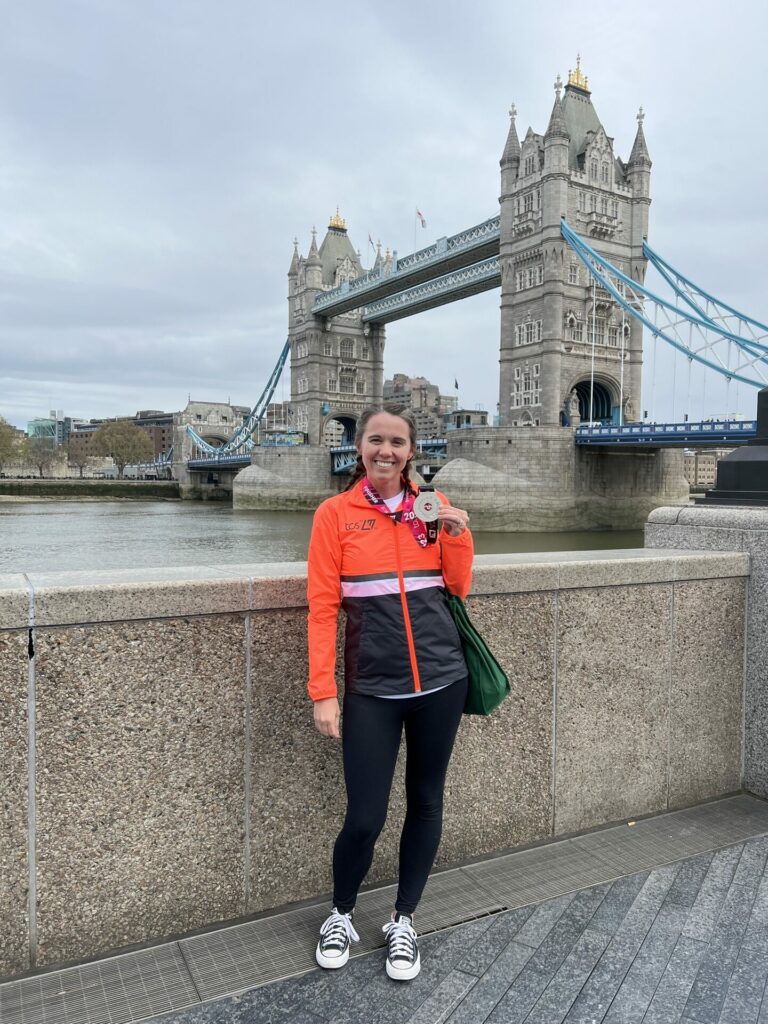
In This Post
- How to get into the London Marathon
- Plan Your Trip (choosing your flight, how long to stay, where to stay)
- Getting Around London
- Things to do in London Before the Marathon
- Sleep & Jet Lag
- Food & Nutrition
- London Marathon Expo (TCS London Marathon Running Show)
- Race Day (getting to the start, course basics, leaving the race)
- Sample Weekend Itinerary
- Packing List
- 10 London Marathon Tips for Travelers
How to Get Into the London Marathon
None of this is going to helpful unless you actually secure a spot in the London Marathon. Earning a spot, especially as a foreigner, can take longer than training for the marathon itself.
You can find all of the official entry information and links on the London Marathon website. If you’re already in, skip down to the next planning section.
London Marathon Lottery
Entering the lottery is the cheapest and most popular way to get into the London Marathon. Ballots usually open on race weekend for entry to the following year’s race. The lottery remains open for about a week and is completely free to enter. Be sure to sign up for the London Marathon mailing list or follow them on social to find out when the ballots open.
The London Marathon draw is completely random, regardless of where you’re from and how many times you’ve entered. The only way to increase your odds is to make a donation to the London Marathon Foundation to get an extra entry or a pay for a second chance entry.
If you’re selected, you will then have to pay the entry free to secure your spot.
The odds of getting picked aren’t great. The exact numbers aren’t released in real time, but in 2019 only 13% of ballots received a place in the race (source). Or according to this article, there were 840,000 applications for the roughly 50,000 slots in the 2025 race — a success rate of closer to 6%. Personally, I’ve entered the general lottery six times and never got picked.
There are sometimes special drawings and challenges for additional slots that may vary by year. For example, the Abbott World Marathon Majors sometimes offers drawings for runners who are working on their Six Star Journey and had received 3 to 5 stars already. (This is how I personally received my London Marathon Entry.) Abbott also has a Road to the Majors series, where you can pay to run virtual races that can earn you an entry into a drawing for the majors, including the London Marathon.
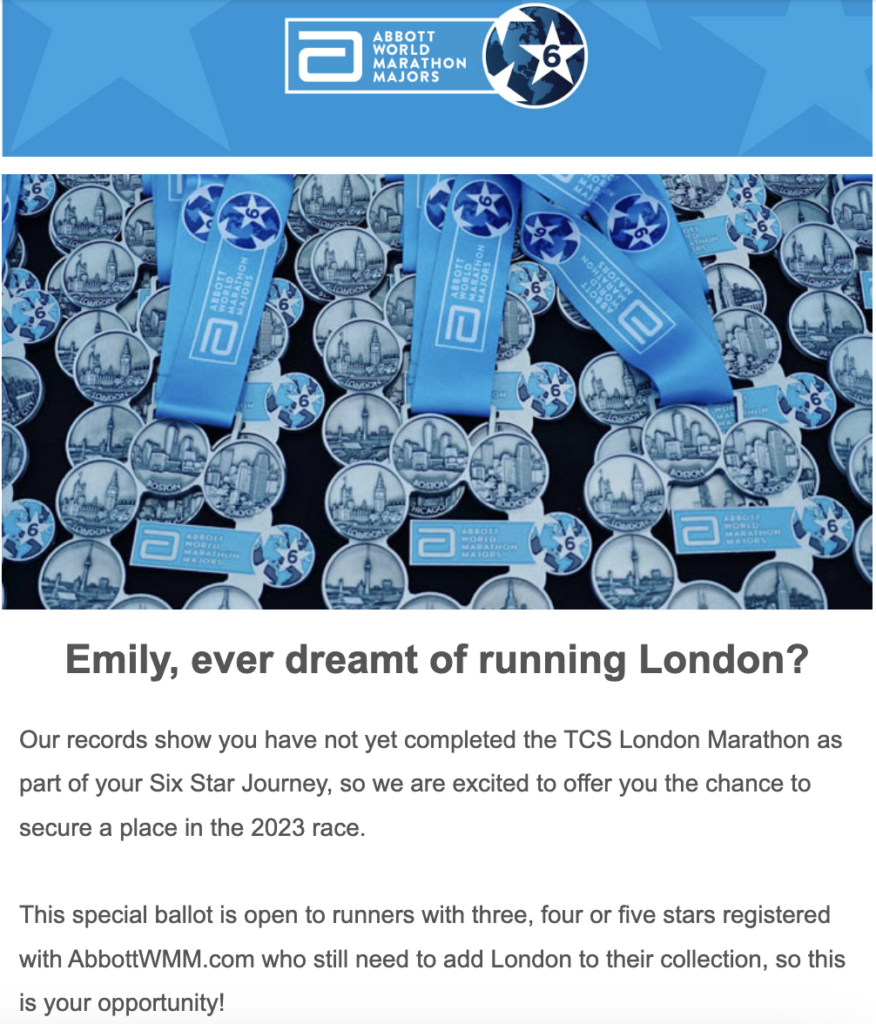
Charity Program
Several charities parter with the London Marathon. If you join select charity teams, they provide you guaranteed entry to the London Marathon and in exchange, you agree to a set fundraising amount. The fundraising minimum is usually quite high (£2,000 or more), and if you fall short, you have to pay the difference if you want to keep your entry.
Not all charity partners provide race entry, so be sure to read the details before you commit. This is typically for runners who already have an entry, but still want to support a charity partner. For these partnerships, there is still a fundraising minimum, but it is usually lower than for runners who need entry.
I’ve ran several other marathons for charity, and it’s generally a good option. It can be low-cost to you (if you’re good at fundraising), it’s nice to run for a cause, and it’s sometimes the only way to secure a bib.
International Tour Providers (AKA Buy Your Bib)
The easiest but most expensive way to get guaranteed entry to the London Marathon is booking with a tour provider. Basically, you buy an expensive tour package that often includes your flight, hotels, and sometimes other perks like expo transit. The packages will also include your race entry to the London Marathon.
The details vary greatly based on where you you’re traveling from and the specific package. You can find the official list of partner tour providers here.
I’ve personally never gone this route, but it feels like a fine option if you have the money to splurge on it.
Entry Options for UK Residents Only
There are a few other ways for British runners to get into the race that international runners can’t do.
Most notably is the Good for Age application, is only for UK residents only. This system allows faster runners to earn a place based on their speed. (If you’re not from the UK, that super fast marathon you ran won’t do you any good here.)
There are also a handful of second chance drawings offered to UK residents as well, so keep an eye out for those.
Plan Your Trip
Okay, so you’re in! You’ve probably started your training plan (or at least started thinking about your training plan), and now it’s time to book your trip to London. This section is about planning your trip, including picking out your flights (if applicable) and choosing where to stay and for how long.
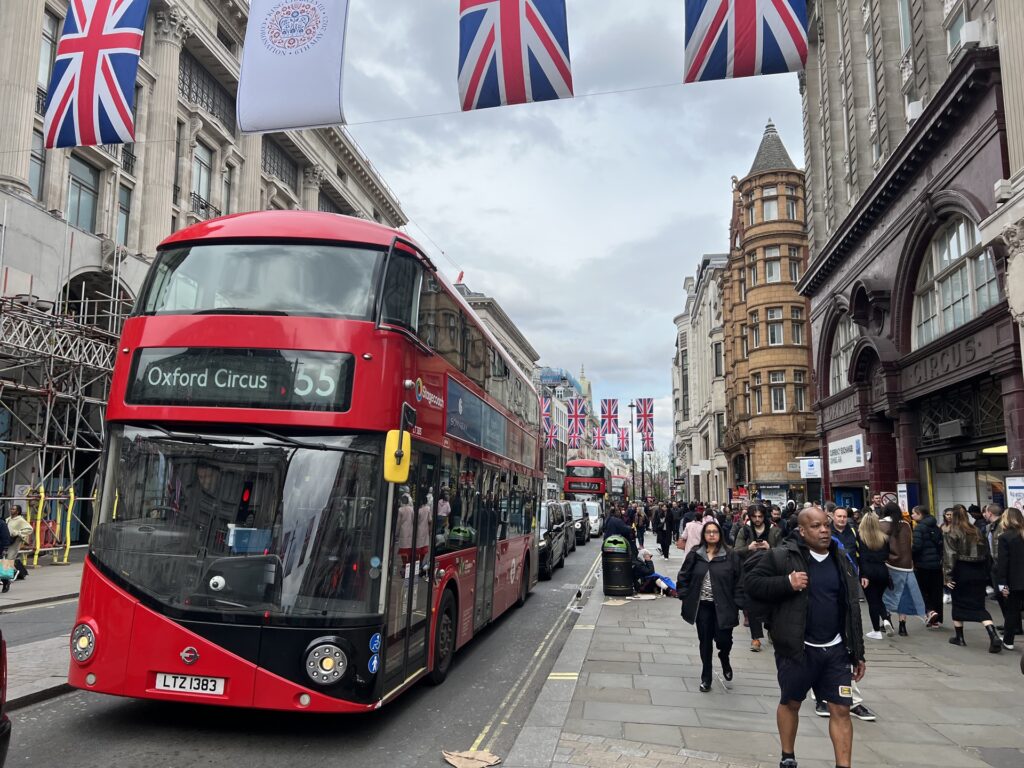
Choosing your Flight to London
The exact flight details will obviously vary based on where you’re coming from. In general though, there are few things to note when it comes to booking your travel to London.
Most importantly, make sure you have a substantial buffer in your schedule that leaves room for flight delays. The London Marathon is always on a Sunday and the required Expo ends Saturday evening. You should plan to arrive in London no later than noon local time on Friday. Ideally, you get to the expo Friday afternoon, but still you have all day Saturday if things go wrong.
Next, think about your travel times. Try to plan flights that work with the time change, not against it. If you’re coming from the west (like North or South America), fly overnight. You’ll have a short night’s sleep, but then you can start to adapt to the new time in the morning. If you’re coming from the east, fly during the day. You’ll have a longer day, but then can go to sleep at a reasonable bedtime on the new local time.
Lastly, consider a flight upgrade — this is especially true if you’re traveling by yourself. There’s no better time to enjoy a full night’s rest in a lie-flat seat than when you’re on your way to a marathon. And let me tell you, there’s nothing more satisfying than sipping on bottomless champagne in your finisher jacket on the way home.
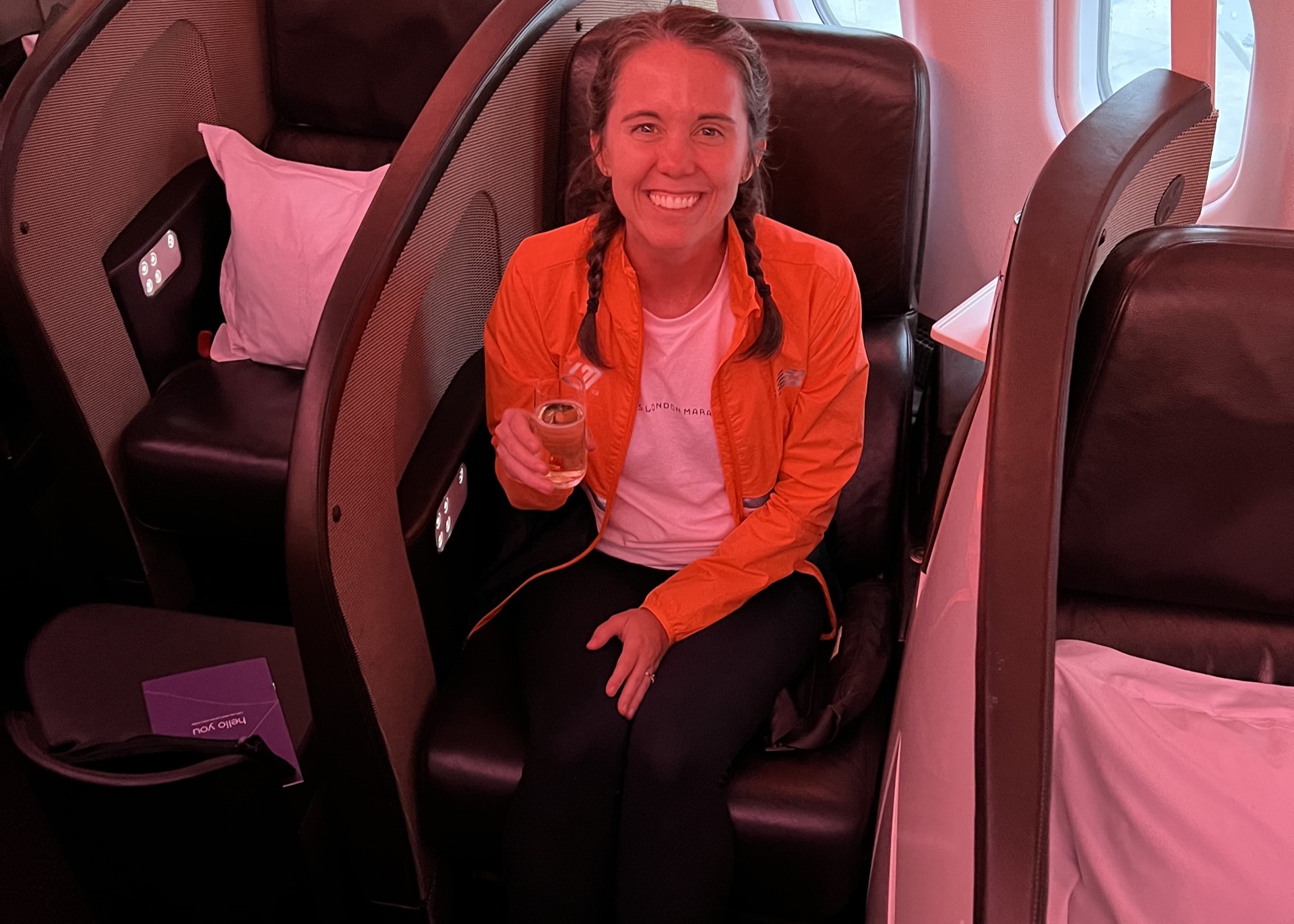
I know flying a premium cabin is a luxury and expensive, but if you have some credit card points gathering dust, this is your sign to cash them in.
How Long to Stay in London for the London Marathon
How long you need to stay in London for the marathon will probably depend on where you’re coming from. In general, I have two pieces of advice.
- However long you think you need, add a another day.
- The London Marathon starts late and ends late. I would advise against any Sunday evening travel plans.
Here’s how long I’d recommend staying in London for the Marathon based on your travel situation.
- Stay in London for 2 nights (Friday – Sunday) if you’re coming from Europe by train and you’re a fast runner. This is about as short of a trip as you can do, and would require a well-timed evening train after the race.
- Stay in London for 3 nights (Friday – Monday) if you’re coming from elsewhere in Europe or if you’re coming from North America and have no extra time to spend.
- Stay in London for 4 nights (Thursday – Monday) if your flight is less than 10 hours and you want to have time to adjust to the jet lag.
- Stay in London for 5 nights (Wednesday – Monday or Thursday to Tuesday) if your flight is more than 10 hours or if you want to make a full vacation out of it.
For my most recent trip from New York City to London, I stayed four days and three nights (landed Friday morning, departed Monday evening). That was not enough time for me to adjust to the time change. Granted, I’m a bad sleeper and ended up getting very sick, so that didn’t help. In either case, if I were to do this again, I would fly in a day earlier to give myself even more time to get my sleep on track.
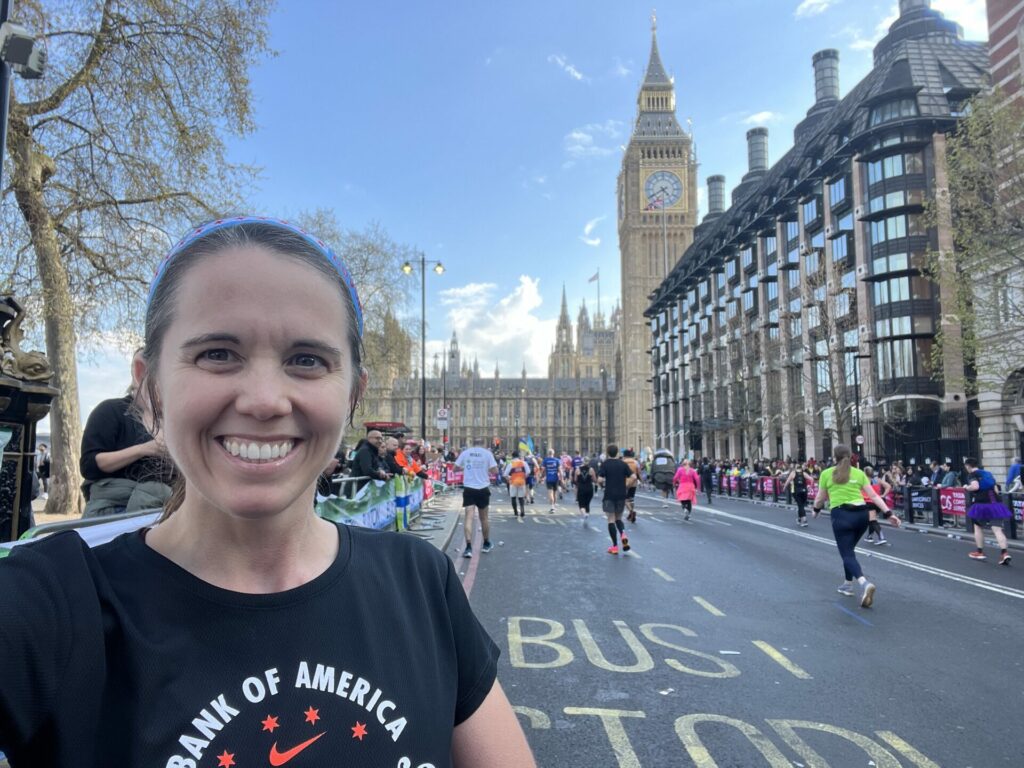
Where to stay for the London Marathon
There are so many things to consider when it comes to choosing a hotel for the London Marathon, but I would argue the most important thing is location. There are so many places you need to get to during race weekend — airport, expo, starting line and finish line — and it’s impossible to be close to all of them.
One option is to pick one of those spots that you care most about (probably the start or finish), and stay close to that area. That means that you’ll have one easy commute and a few longer ones.
Another option is to stay somewhere central that has easy connections to all of those places. I chose this approach, and it worked out great. If you ask me, there are two neighborhoods that are perfect for the London Marathon: Bankside and Finsbury.
Finsbury
Let’s start with Finsbury, because that’s where I personally stayed for the London Marathon. This area is just north of the financial district in the City of London and is walkable to some of my favorite spots in London like Shoreditch and Tower Bridge.
Finsbury is perfect for the marathon because of its proximity to Liverpool Street Station, which serves a variety of important-for-the-marathon train lines. The Elizabeth Line goes directly to both Heathrow Airport and the marathon expo. The start and finish areas are each 30 minutes away by train, each with one transfer.
There are a handful of hotels in this area, but the key is to stay close to both Liverpool Street Station and Mooregate station. I can personally recommend The Montcalm Royal London House, which is on the nicer side. The Travelodge London Central City Road is just around the corner and is a cheaper option in the same area.
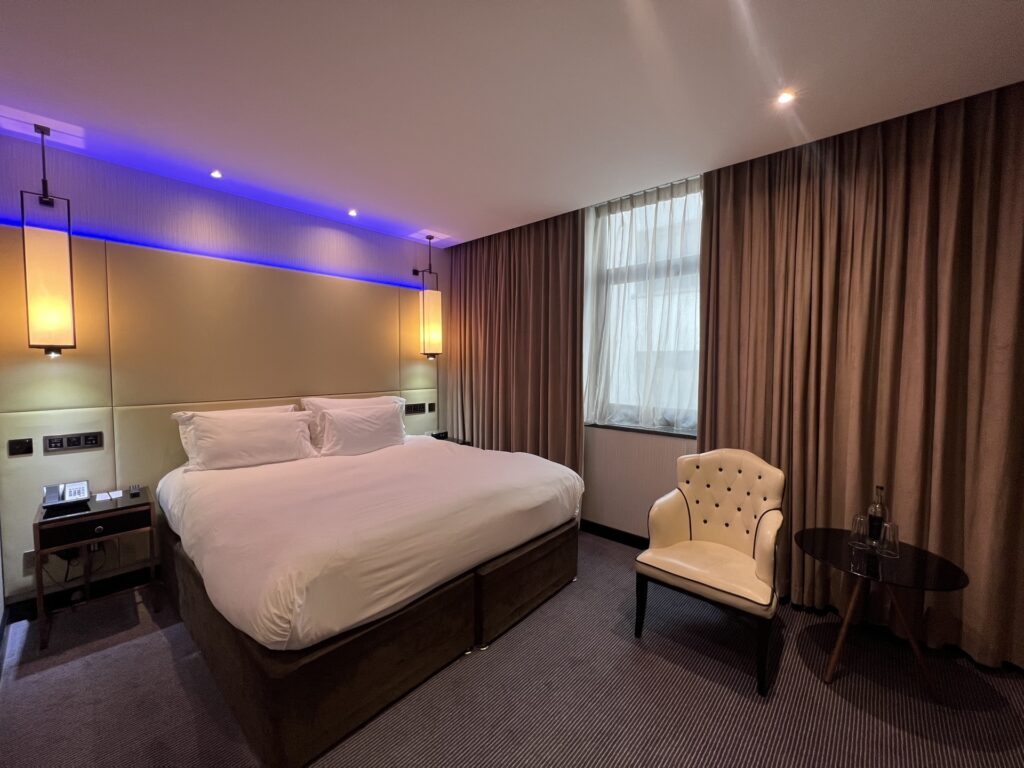
Bankside
Another great option is Bankside, which broadly refers to the south bank of the Thames between Blackfriars Bridge and London Bridge. This neighborhood has tons of cool things to see and do, like Borough Market, Tate Modern, and Millennium Bridge. Plus the street food and entertainment along the riverwalk between there and the London Eye is unmatched.
This area is similarly great for the London Marathon because it’s centrally located between all of the important spots. The start and finish areas are less than 30 minutes away by train and don’t require a transfer. To get to the airport and the expo, you’ll have to take the Underground to connect to the Elizabeth line.
I didn’t stay in Bankside for the Marathon, but I did stay in the area for a previous family vacation. We stayed at Bankside Hotel, Autograph Collection and loved it. For a more reasonably priced hotel in the area, consider the ibis Styles London Southwark.
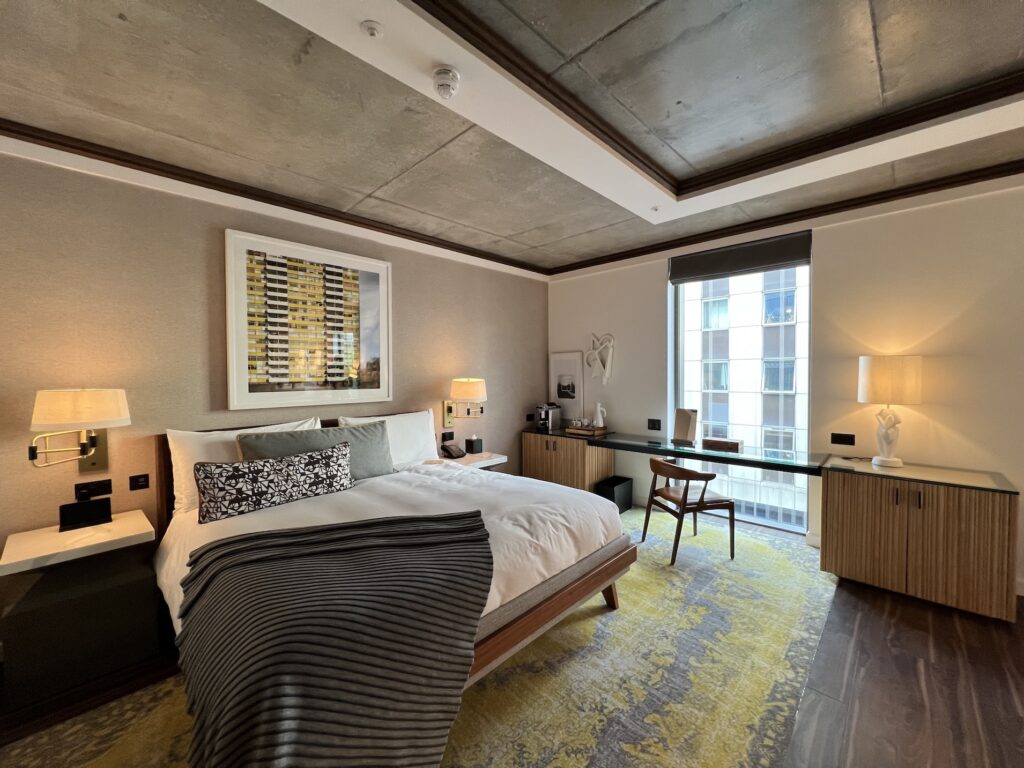
Getting Around London
The best way to get around London is on public transportation, specifically the train. Of course there are also taxis, rideshare and buses, but London traffic is notoriously awful. The train is the best way to avoid the traffic and get where you need to go quickly and cheaply.
Consider this section a crash course and all things trains for London Marathon Weekend.
Types of Trains in London
There’s a few different rail lines and operators in London. These are the ones that matter most for marathon weekend.
All of these trains offer free service to runners on marathon day. During my race, you just had to show your bib at the station. However, it appears that they now provide a 24 hours transit card at packet picket. If you’re taking the train any other day, you can simply tap a contactless credit card when you enter and and exit the station. There is no need to buy a separate ticket or travel card to ride any of these trains.
- London Underground (aka the Tube): This is the intercity London subway system that connects all of Central London. You’ll probably take the tube from the finish and around the city during your stay, but it’s not ideal for getting to the Expo or the starting areas. (We also have an entire guide to riding the London Underground if you need details on that.)
- Elizabeth Line: This looks and feels like the London Underground, but it’s technically a different type of train. This is the line that goes to the London Marathon expo and Heathrow Airport.
- Docklands Light Rail: This is an above-ground, driverless tram that has limited service around parts of Central London. The DLR stops at Greenwich station, which is the closest station to the Red Start.
- Southeastern: This is the regional train line that connects Central London to the outskirts and nearby towns. These trains stop near all of the London Marathon start areas.
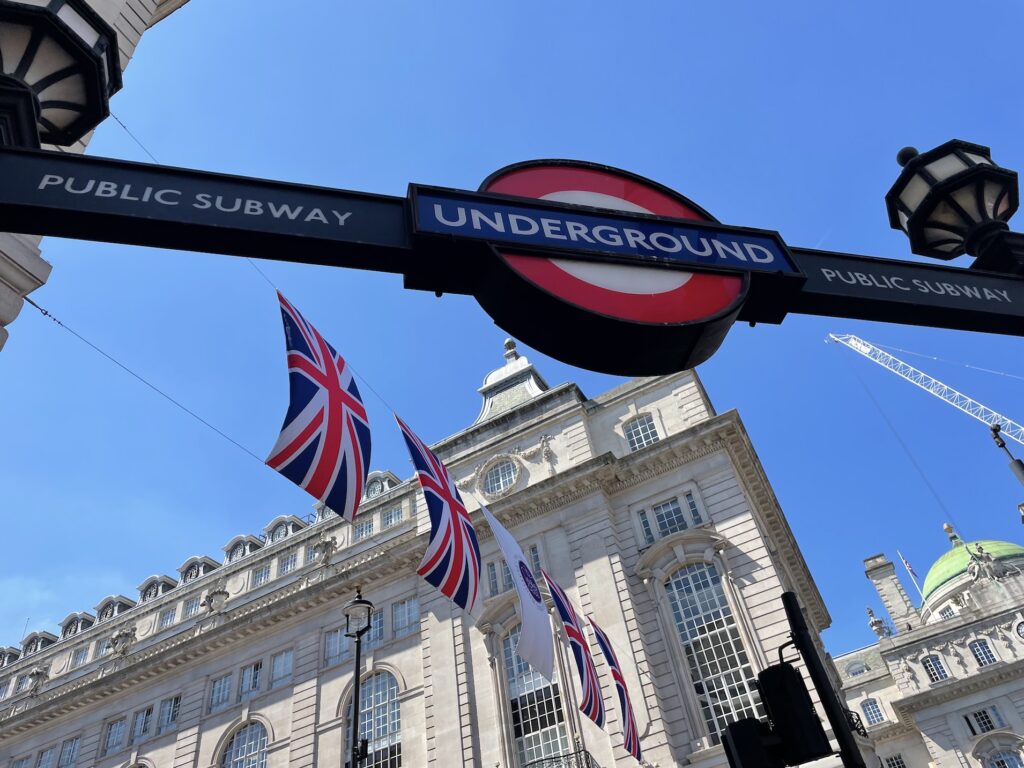
How to get from the Airport to Central London
If you’re coming from London Heathrow, there are three train options to get into the city center.
- Heathrow Express: Fastest, but most expensive. This train runs express from Heathrow to London Paddington only.
- Piccadilly Line (London Underground): Slowest, but cheapest. This train makes all station stops from London Heathrow to Central London and then heads north after Covent Garden.
- Elizabeth Line: The Elizabeth Line connects Heathrow to Eastern London. It’s usually the best option if you need to go somewhere other than Paddington but don’t want to make all the stops on the Piccadilly line.
If you’re coming from Gatwick, the fastest option is the Gatwick Express which runs direct to Victoria Station. Other train options include Thameslink, Southern Railway, and GWR.
Things to do in London Before the Marathon
London is one of my favorite cities in the world. I love all the parks, the abundance of halloumi, and the pub culture. Every time I go to London, I discover something new. The hard part about visiting London during a trip for the London Marathon isn’t finding something to do, it’s finding too much to do!
On most trips I could spend entire days walking the streets of London, but during my marathon trip I had to proactively remind myself to take it easy. I also had to pay attention to my nutrition, and that meant drinking fewer beers than I otherwise would have. (Note: I said fewer, not none.)
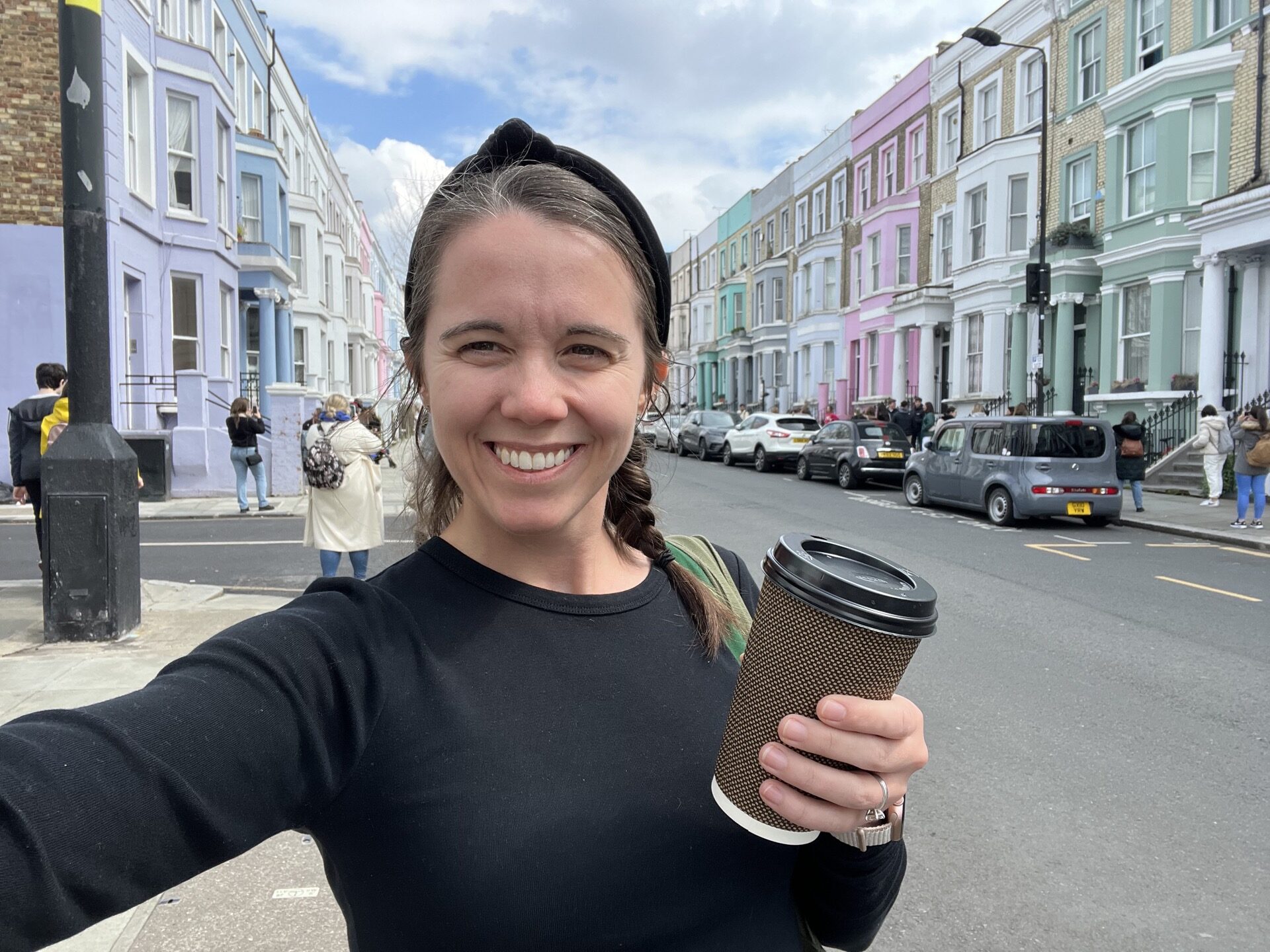
Here are a few things to keep you busy, but rested in the days leading up to the London Marathon.
- Go for a shakeout run! I recommend the riverfront on the south bank between Millennium Bridge and the London Eye.
- Ride the Uber Boat water taxi between Embankment and Tower Bridge.
- Explore a small museum like the London Transport Museum or head to the free Tate Modern and stick to just one floor or section.
- Pack a picnic for St. James’s Park.
- Ride the iconic London Eye and then walk to the newly restored Big Ben.
- Pick a single neighborhood to explore, like Notting Hill.
- Hit up Spitalfields Market for some unique shopping and then do some carb-loading at nearby Chi Chi and the Pasta Family food truck.
- Take the canal boat from Little Venice to Camden Market.
- Enjoy the views from the city’s highest indoor garden at Sky Garden. (Be sure to make a free reservation in advance.)
- Head to Borough Market for fresh produce, juice and other healthy options or pick up my favorite pasta from La Tua Pasta if you’re still in need of carbs.
And this one goes without saying: visit the marathon expo! You have to go to pick up your bib, but you might as well make an afternoon out of it. Here you’ll find the official race merchandise, a ton of great photo ops, lots of running related vendors, and some food and drink options.
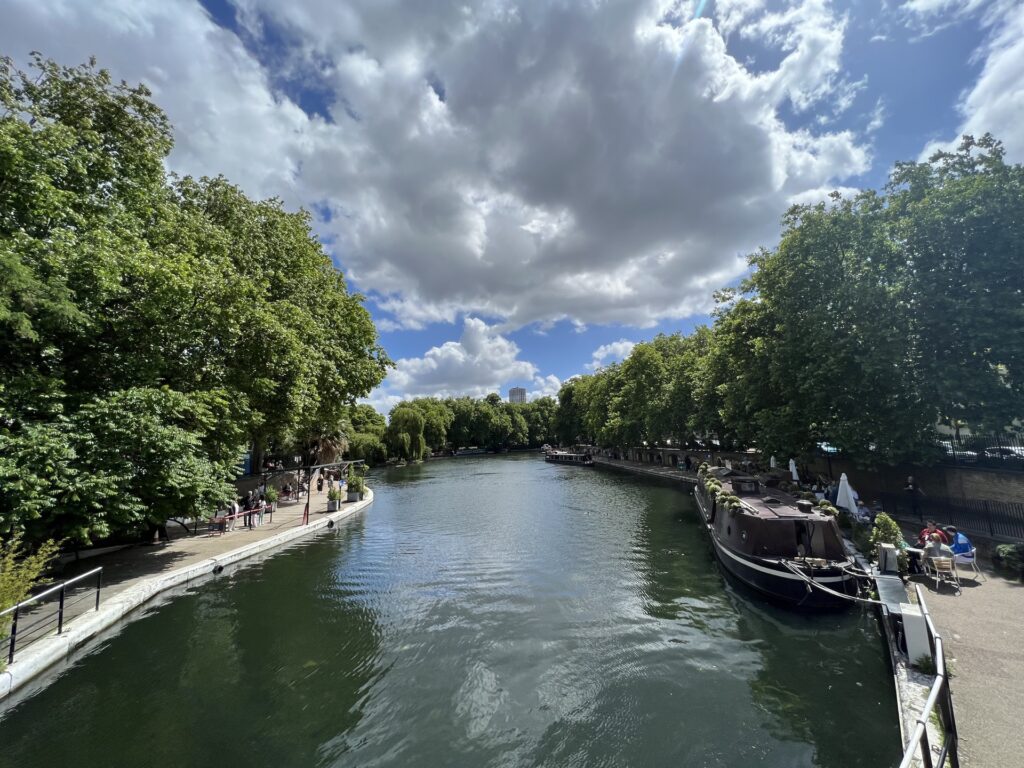
Read more! If you’re bringing your family with you for race weekend, check out our post with the best Things to do in London with Kids.
Sleep & Jet Lag
If you’re traveling across time zones to get to the London Marathon, this is a huge deal. You want to adjust to London local time as quickly as possible. This was something I did really bad it and ultimately contributed to my poor performance on race day.
So how do you do that? Here are some things that have historically worked well for me on international trips.
- Give yourself time. I’d suggest at least 3 good nights of rest on London time before the race. In my experience, an overnight flight and then two nights in a hotel before the race was not enough.
- Don’t nap on your first day. To adjust to the time change faster, you really have to power through your first day. Avoid taking a nap during the day so you can be tired and ready to fall asleep at a reasonable hour on London local time.
- Soak up the sun. Natural night has a huge effect on our circadian rhythm. Spend the daytime hours outside so your body can pick up on the new day and night queues.
- Pick a hotel with blackout curtains. Along the same lines, a hotel with blackout curtains will reinforce nighttime and help you sleep better. It’s extra important if you need to go to bed a a little earlier because of the jet lag. Both hotels I recommend for the London Marathon (Montcalm Royal London House and Bankside Hotel) have quality blackout curtains.
- Try Liquid I.V. Sleep Multiplier. I heard about this from someone who traveled from the US to run the Tokyo Marathon and swore by it. I tried it on a non-race trip to Italy and it worked like a charm. This might be a placebo effect, but if the placebo works, who cares? And even if it doesn’t help you sleep, it still provides increased hydration which is also important for both jet lag and pre-race fueling. (You can buy it on Amazon here.)
The good news on the sleep front is that the London Marathon actually starts pretty late in the day. The London Marathon start waves usually begin around 9:30 AM, with staggered starts over the next few hours. (Compared to the Chicago Marathon which starts between 7:30 – 8:30 AM, that’s pretty nice!). I was in the Red Start and my recommend arrival wasn’t until 9:45 AM and I didn’t start until after 11.
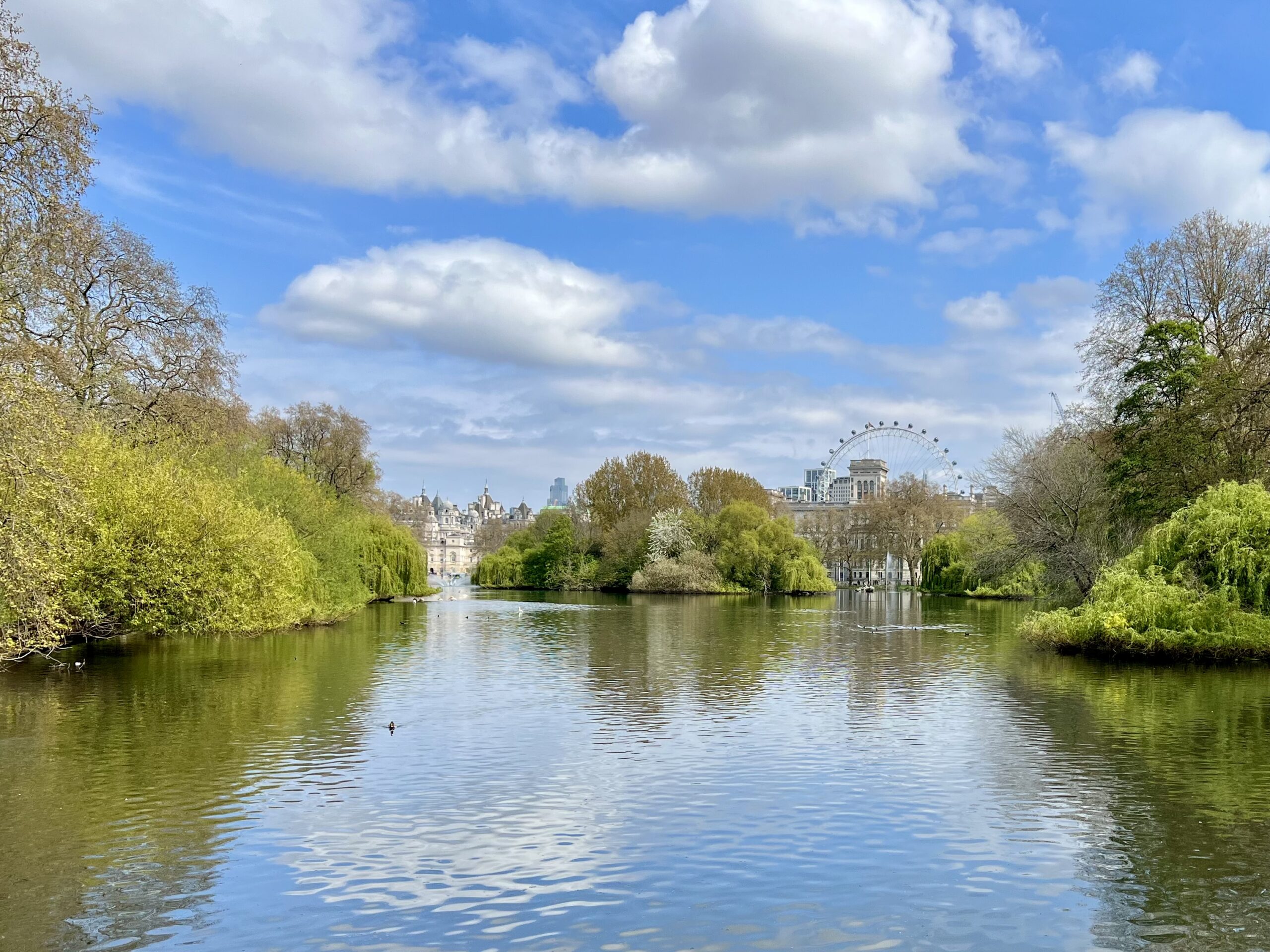
Food & Nutrition
One of the most difficult things about an international marathon is managing food and nutrition. The specific foods and drinks available are different, you have to eat out more, your meal schedule is wonky. Plus, you’re in London, so it’s easy to be tempted by fish and chips and cask ales.
I’m not a nutritionist, so I won’t speak out of turn. However, I did want to mention this, because it’s not something I proactively planned for. My nutrition was really bad for the London Marathon, both before and during the race.
Here’s a few things I learn from this experience.
- Train with a meal you know you can get in London. During training season, I always ate penne with red sauce and a slice of garlic bread the night before my long runs. I knew it sat well in my stomach, and I also knew that I could find a restaurant in London that sold a very similar meal. I highly recommend this approach!
- Drink lots of water. Long flights are dehydrating. I know this, and yet I constantly fail to properly hydrate. Drink plenty of water during your flight and in the days leading up to the race.
- Don’t forget to eat. On my arrival day, I was so busy running from the airport to my hotel to the expo, that I didn’t realize it was 4 PM and I hadn’t eaten all day. I then proceeded to scarf down an entire appetizer platter meant for four and a side of fries at a pub. The next day, I didn’t want to wait in line at any of the food trucks at the market I was at, and again failed to eat all day. 10/10 do not recommend.
- Hit up Tesco Express. I was honestly just waiting for the right time to talk about my love affair with Tesco. They have full grocery stores but also 7-Eleven style convenience stores all over London. You can find prepared foods like sandwiches, salads, cut fruits and veggies, yogurt, and so much more. It’s a good place to pick up some healthy-ish foods to eat in your hotel or on a picnic so you’re not gorging on restaurant food constantly.
- Bring your own fuel for race day. There is not a lot of fuel provided on the course. I learned that lesson the hard way. Plan to bring fuel with you (from your home country if you’re not sure if they sell it in London) and carry it with you during the race.
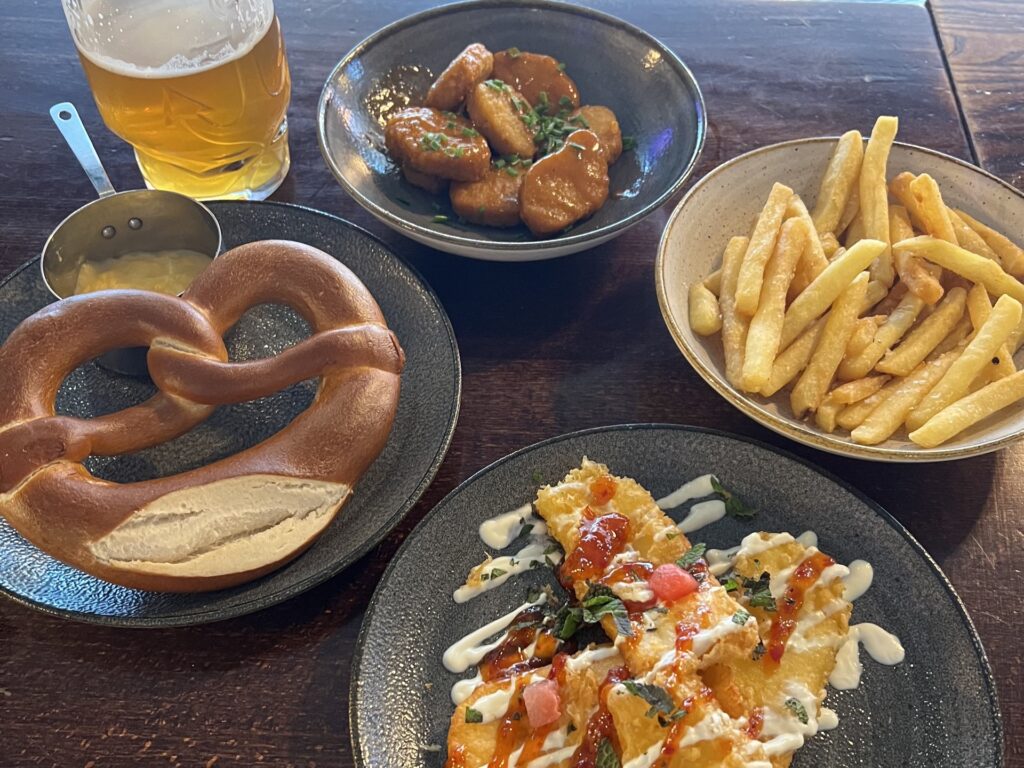
London Marathon Expo (TCS London Marathon Running Show)
The London Marathon expo is officially called the TCS London Marathon Running Show. It’s held at ExCel London, which is a large convention center on the east side of Central London just across the Thames from Greenwich.
You have to visit the London Marathon Running Show before the race to pick up your bib. The expo is open to the public, so feel free to bring your friends and family if they came with you.
If you’re traveling for the London Marathon, I’d suggest going to the expo was soon as you arrive. It was a well managed event, but I can imagine it being pretty awful on Saturday. Plus, going early will also get you the best pick of gear selection and sizes.
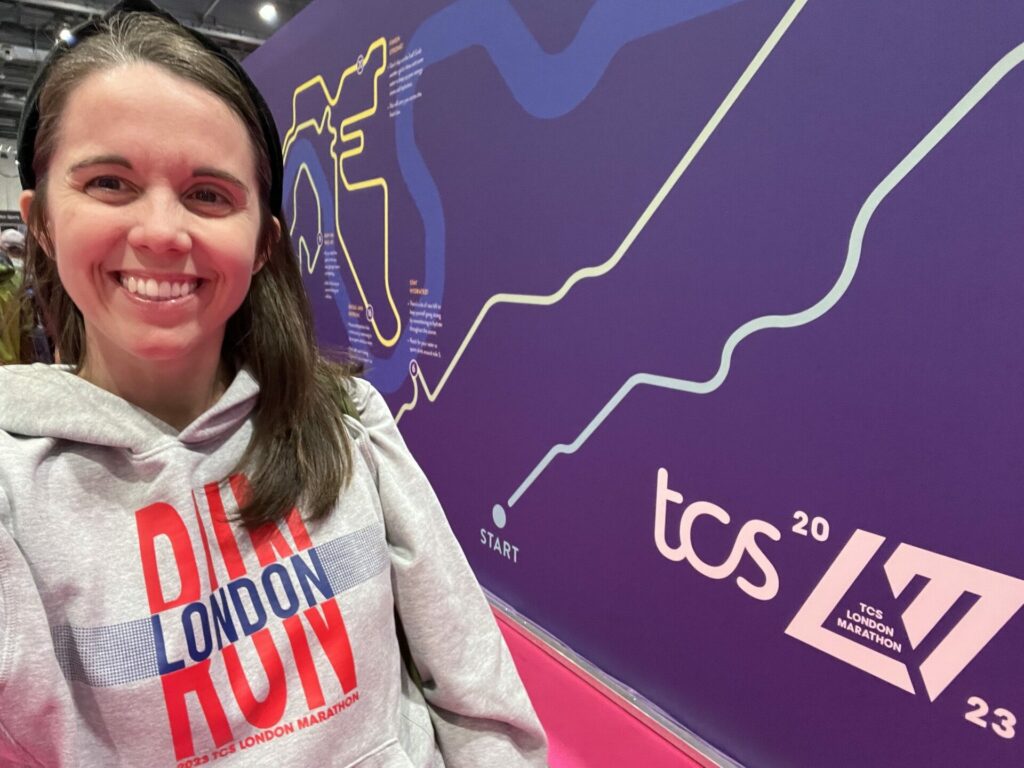
Getting to the London Marathon Expo
ExCel London is easily accessible via public transportation. Take the Elizabeth Line or the DLR to Custom House, which is adjacent to the convention center where the expo is held. Public transportation is not free for runners to the expo, so you’ll have to tap your credit card when you get on and off the train.
After exiting the station, there are signs and volunteers directing runners toward the convention center entrance. I don’t know who needs to hear this, but there’s a Starbucks right by the station. Inside, the convention center felt a bit like a mall food court, with some fast food restaurants and cafes.
There are plenty of signs and crowds that lead toward the actual expo location, and the entrance was clearly marked. It did seem like they were prepared to limit entry to manage capacity, but there was no line to enter when I arrived on Friday at 1 PM.
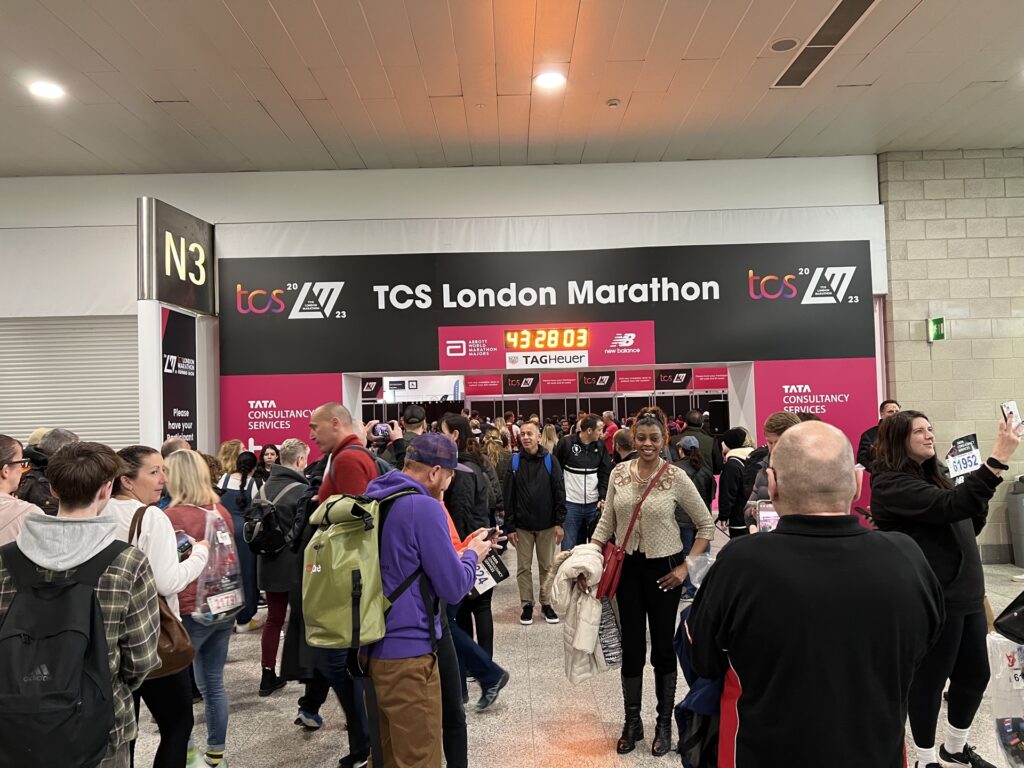
Bib Pickup
The first thing you hit after walking into the expo is bib pickup. There are a bunch of booths in a row, and you can go to any one. The queues are not separated by bib number or anything. You need your QR code (sent via email) and a photo ID to get your bib. I forgot my passport at my hotel, but my US driver’s license worked perfectly fine.
It was a little crowded when I was there (Friday, 1 PM), but they moved people through really quickly. I went to a line near the end and was done in 3 minutes. Easy peasy.
Note: At my race, runners received finisher shirts instead of participant shirts, which were distributed at the finish line. However, in 2024, they switched to distributing shirts at the Expo. Be sure to check the shirt situation for your race to see where t-shirt pick-up is located.
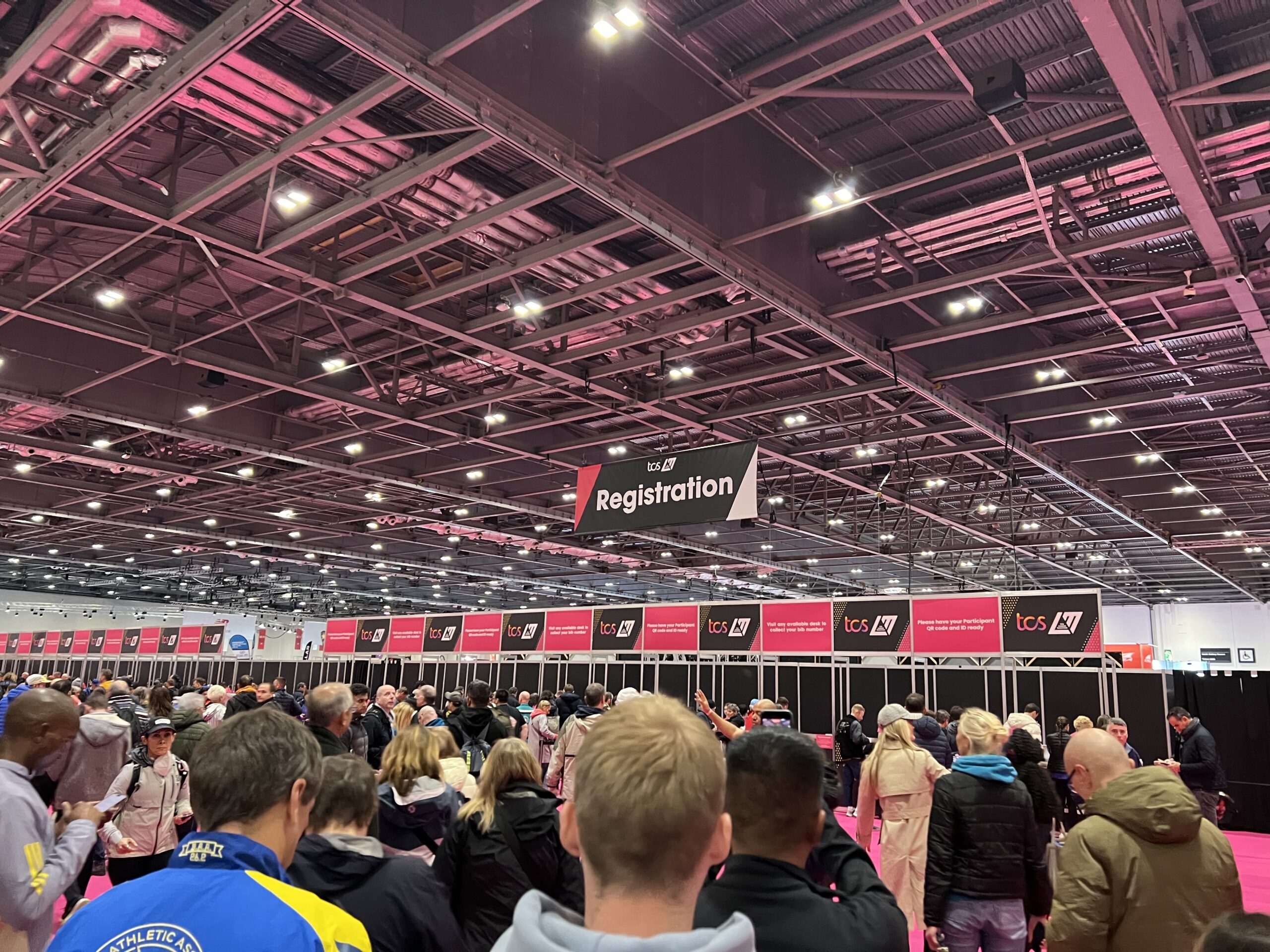
Official London Marathon Race Gear
Just beyond bib pickup was the official race gear shop. Official London Marathon apparel is by New Balance. They do sell it online in advance, but it doesn’t ship internationally. So if you want any race swag, you’ll need to get it at the Running Show. I thought the gear was really good, and I spent way too much money on it.
The big ticket item is the official jackets, which were available in neon and black my year. They were just selling out of popular sizes and colors when I arrived (Friday, 1 PM). The women’s neon was almost entirely gone and the black were going quickly. The men’s jackets lasted a bit longer, but those too were pretty picked over by the time I left the area.
Other than the jackets, there seemed to be adequate sizing available for most other items, and they were actively restocking things. There was a long line for checkout, but it was really well organized and moved quickly.
The shopping area was packed. Granted I was tired and came straight from a redeye flight, but I found this experience to be incredibly overwhelming.
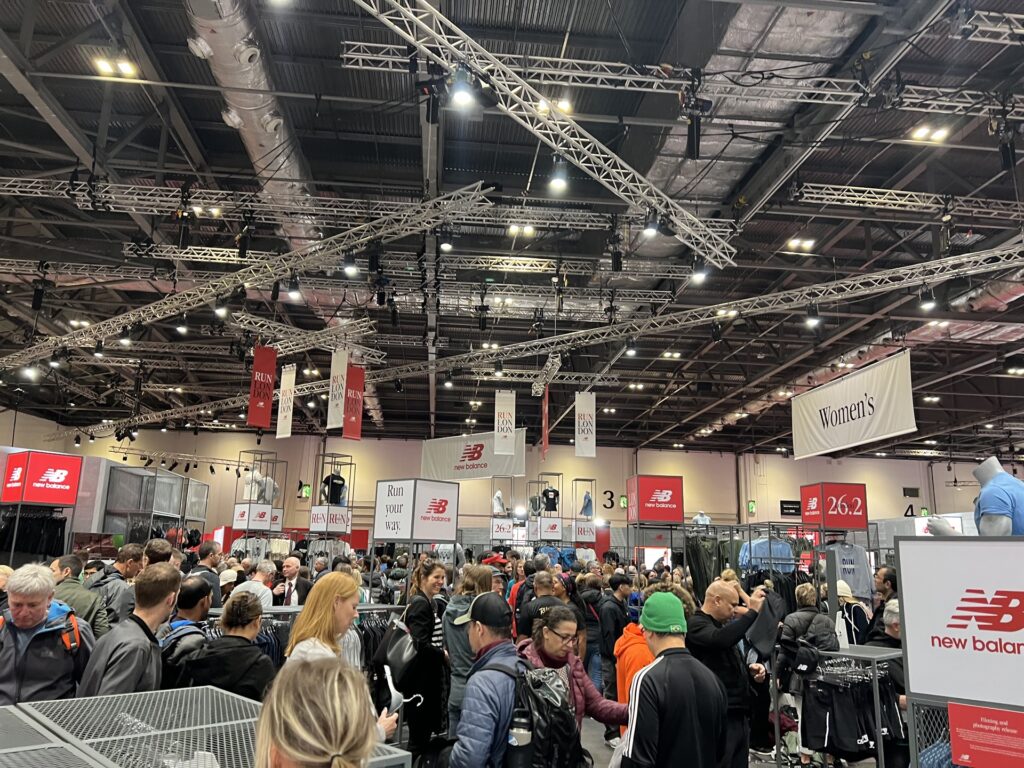
The Rest of the Running Show
After the official merchandise area, there was the rest of the general expo. This was pretty standard in size and quality.
Here are a few things to expect from the expo.
- Booths for upcoming races and charity groups
- Running related gear and apparel
- Cafe with food and drinks for purchase (including coffee)
- Photo ops including photo walls, digital experiences and green-screen/prop photos
- Massage area (for purchase)
- Custom shirt printing (advance booking required, may vary by year)
- Bathrooms (long line for Women)
Overall, the TCS London Marathon Running Show was fine. It was pretty standard as far as Major Marathons go. I spent about an hour there, and then carried on with my day.
London Marathon Race Day
If all things have gone well until this point, you should be in good shape. It’s finally race day and it’s time to “trust your training,” as they say.
Like I already mentioned, I’ve only run this race one time. I’m not a pro on the course and I’m also not a fast or particularly serious runner. So in this section, we’ll mostly focus on the logistics. I’ll trust that you will look to the experts for actual running advice.
About the London Marathon Start
The London Marathon starts in Greenwich Park. There are four assembly areas in the park (red, blue, green, yellow), which are assigned based on speed and entry type. There are then three different starting lines (Red, Blue, Green), which take a slightly different route until they merge at miles 1 and 3.
Inside each start assembly area, there is gear check, first aid, water station, and restrooms. At my start area, everything was clearly marked and there were plenty of volunteers around. I arrived late (because I took the wrong train,) but I was surprised to find that there was no wait for gear check or restrooms(!) in the Red Start area. (As a Chicago Marathon regular, this is unheard of!)
In addition to your colored start area, you will also have a wave number. (Both of these things will be assigned via pre-race communications and indicated on your bib.) Within each colored start area, there are signs for each wave number. Volunteers walk runners by wave number to the starting line, where the race will begin.
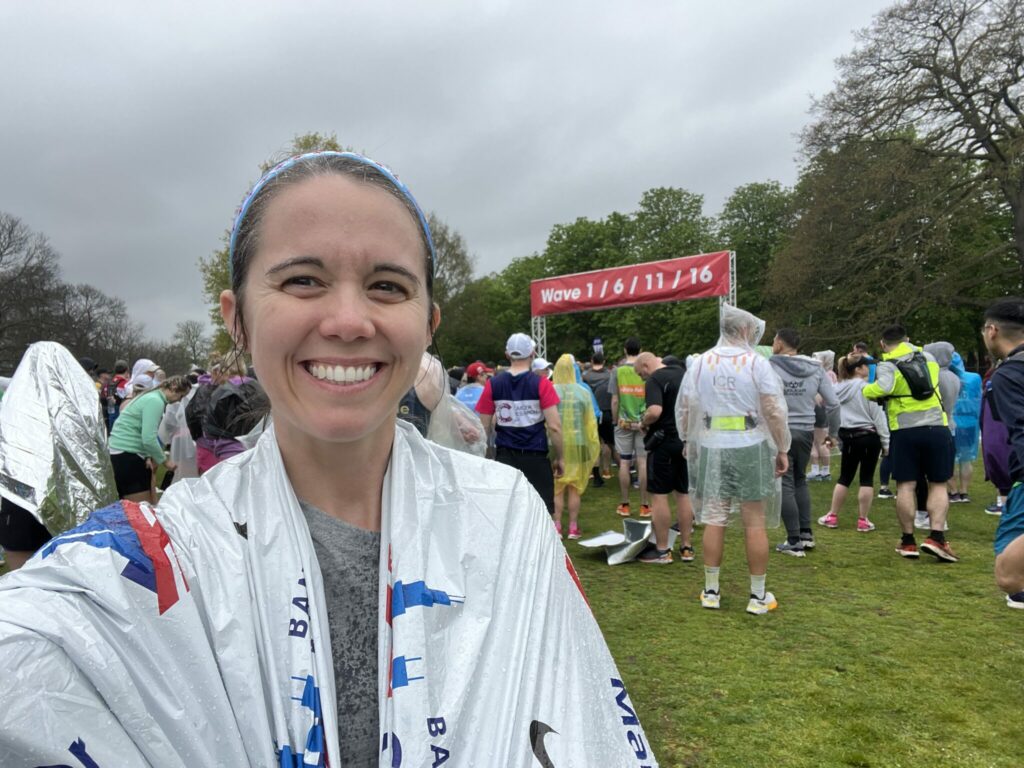
Now, I’m actually a little confused about what happened here. There were 20 waves in our assembly area, but only 5 different gates. For example, as you can see in the photo above, waves 1, 6, 11 and 16 all shared one gate. Volunteers then moved runners to the start by gate, not wave. (So waves 1, 6, 11 and 16 all went to the start at the same time.) So I’m not actually sure why they had 20 waves and not 5. Maybe I missed something and went before I was supposed to.
Either way, someone will eventually tell your group to start. As long as you’re at a gate, you won’t miss it.
Getting to the London Marathon Start
Greenwich Park is big and has three nearby train stations. Below is a look at which stations are closest to which start area. However, don’t panic if you get off at the wrong station (like I did.) It’s possible to reach any of the start areas from any of the three nearby stations, you just might have to walk a bit further.
- Red Start: Greenwich Station via Southeastern rail or DLR
- Green Start: Maze Hill Station via Southeastern rail
- Blue & Yellow Start: Blackheath station via Southeastern rail
Note: Refer to your pre-race instructions for your exact arrival time and recommended transportation.
Tip: Look out for signs at London Bridge Station for directions on what platform to go to for what start color.
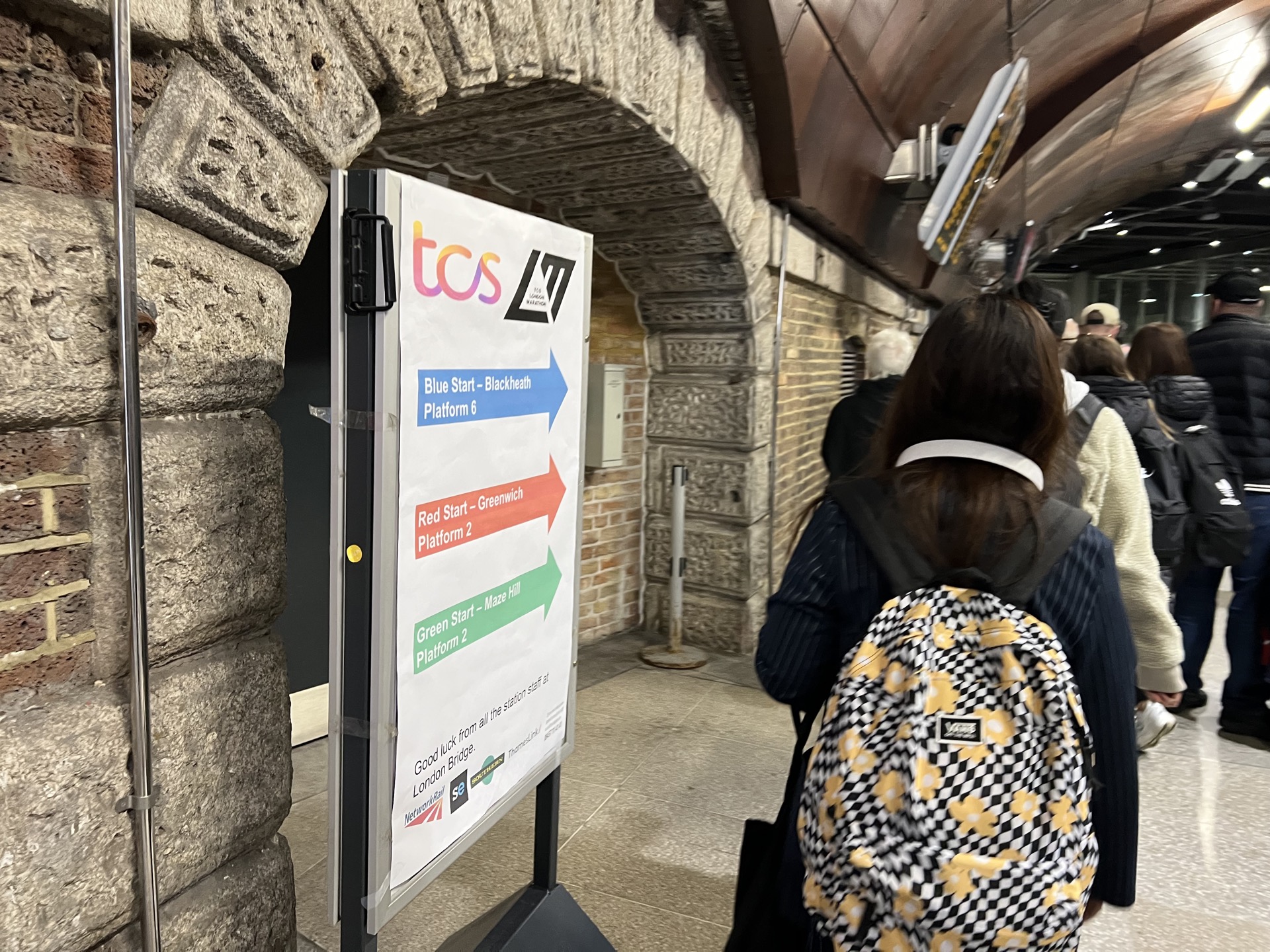
Transport for London is well aware of the mass crowds for the London Marathon and does its best to increase service. The DLR starts running early and Southeastern runs more trains. That said, in my experience, transportation to the start was a nightmare.
Boarding the train at London Bridge station was chaotic, and people poured through the gates and packed onto trains as best they could. Then the train was delayed and we sat not moving for 30 minutes — cramped on a hot train. People who had earlier starts than me were panicking because were just trapped on the train.
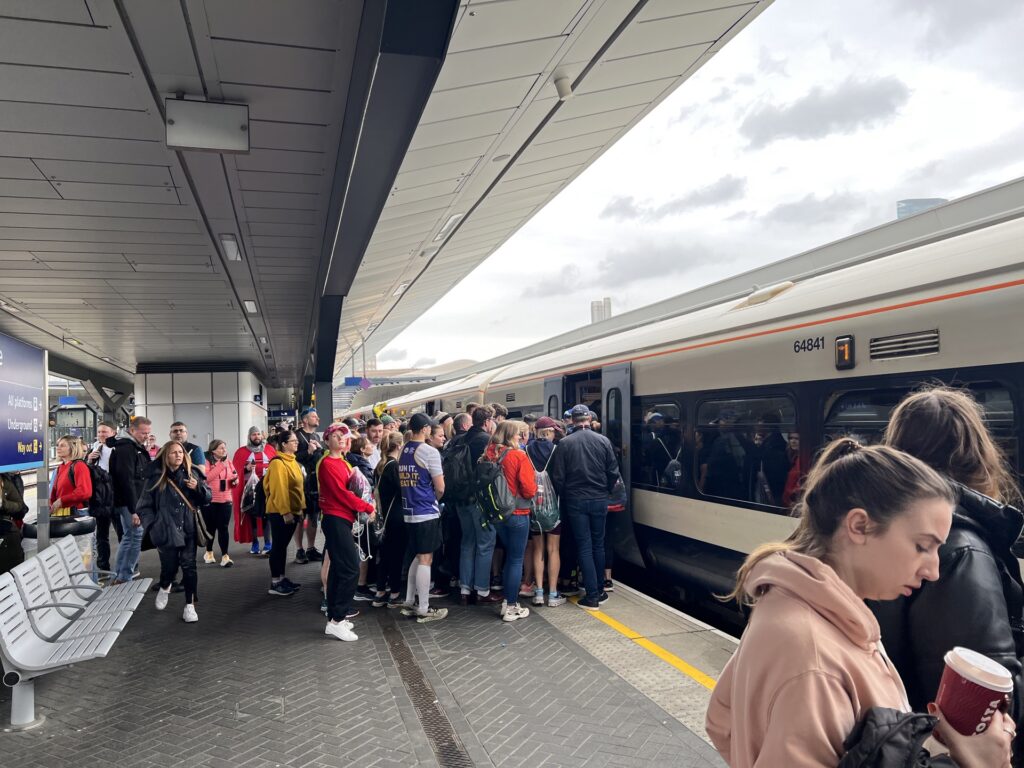
I can’t say for sure that the DLR would be better, but I can’t imagine it could have been worse than Southeastern. If you have the option, I would recommend at least trying the DLR to Greenwich, even if you’re not in the Red Start.
Once I got to the park though, everything was smooth. Everything was really well labeled and there were plenty of volunteers out directing runners.
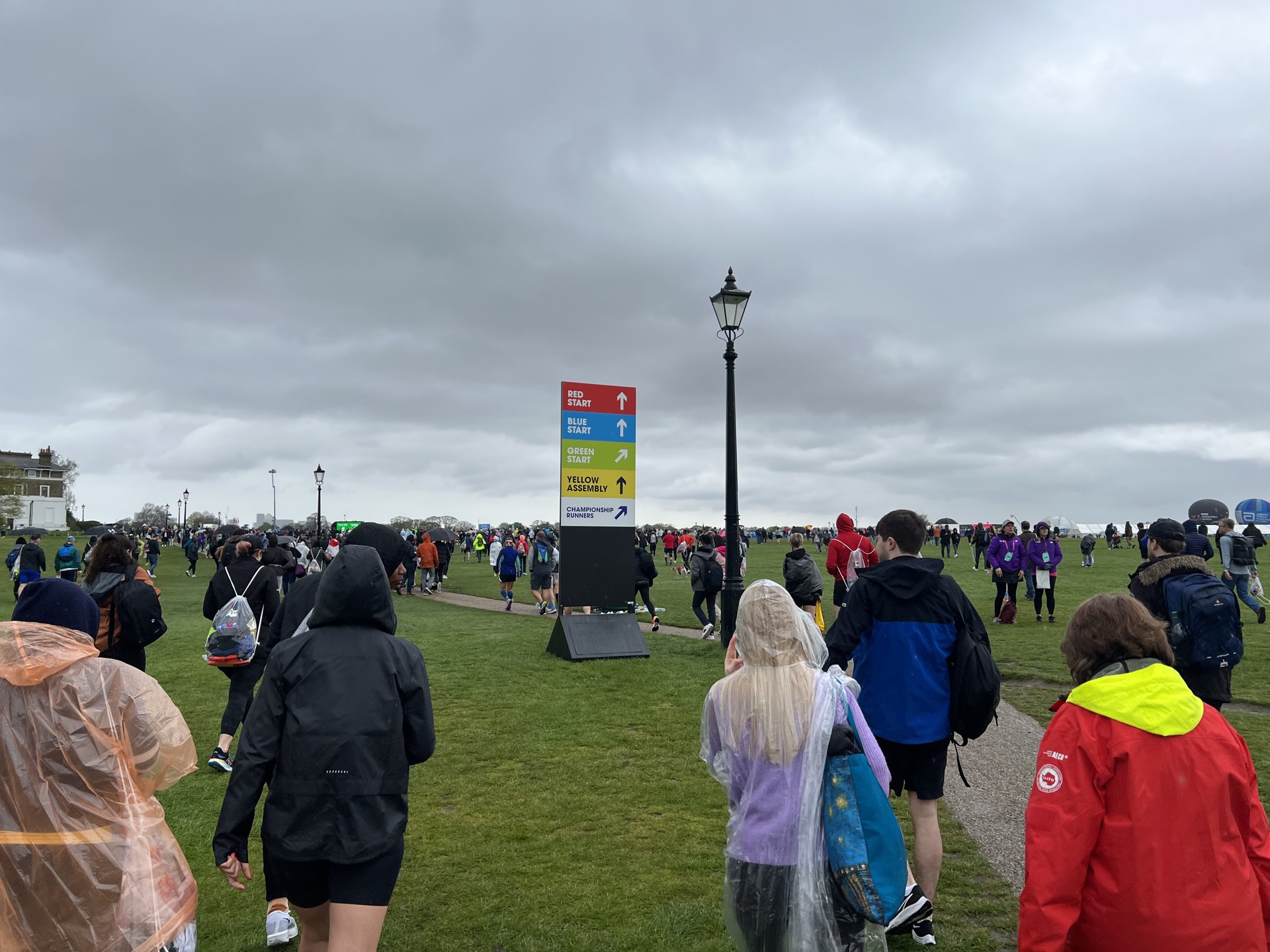
London Marathon Course Basics
The London Marathon is a point-to-point course that starts at Greenwich Park and ends on The Mall just past Buckingham Palace. It’s a mostly flat course that weaves through Central London north and south of the Thames. The first half of the race is largely through residential areas, while the second half is through more commercial and touristy districts.

For me (and I would assume most people), running over Tower Bridge was the most memorable and iconic moment on the course. I’m an emotional runner and I was brought to tears by the roar of the crowds as I made the turn toward the bridge. I had dreamed of this moment since I started running, and it was every bit as magical as I hoped it would be.
Like most major marathons, there are numerous aid stations along the course. Unlike any other major I’ve run though, water was distributed in small plastic bottles with the intent that you carry it with you (no one did). The sports drink (Lucozade) was served in the standard compostable paper cups.
There are typically 12 aid stations with water on the London Marathon Course, including 4 that also offer sports drink and 2 that have sports gel (Lucozade). No food was provided on the course. This felt very light to me. By contrast, the Chicago Marathon has 20 aid stations, all of which have both water and Gatorade. I didn’t plan for this and deeply regretted not bringing my own fuel.
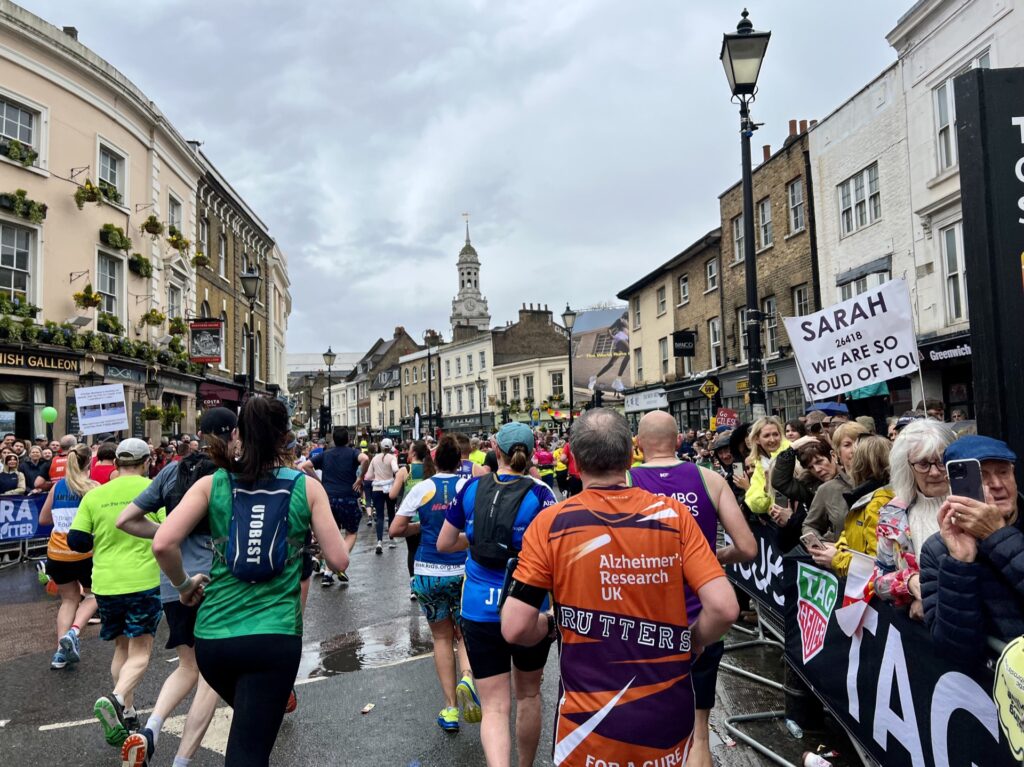
Crowds were good, even on a rainy day, and there was a steady wall of people along the entire course. However, there were a few places where the crowd energy was much higher, and that included popular spots like around Cutty Sark, before Tower Bridge, somewhere in City of London (honestly can’t remember the exact location), and then the entire stretch from Embankment to the finish.
The finish line itself was a bit dull though. (This is pretty standard for later finishers at major marathons.) It’s lined with bleachers, which are usually packed for the elite finishers. However, by the time I got there most of those spectators had left this area. Which leads me to …
London Marathon for “Slow” Runners
Slow is relative, and finishing a marathon at all is impressive, no matter your time. I’m here to assure any runners worried about their speed that you are welcome at the London Marathon.
I trained really hard and had visions of a 4:40 PR. Unfortunately, it wasn’t my day and I ended up finishing with a time of 5:45. I wasn’t the very back of the pack, but I definitely wasn’t the front and my experience running London was still very positive. Crowds were mostly still out for my entire race, there were plenty of other runners at my pace, all the aid stations were fully supplied the entire time, and I never felt alone.
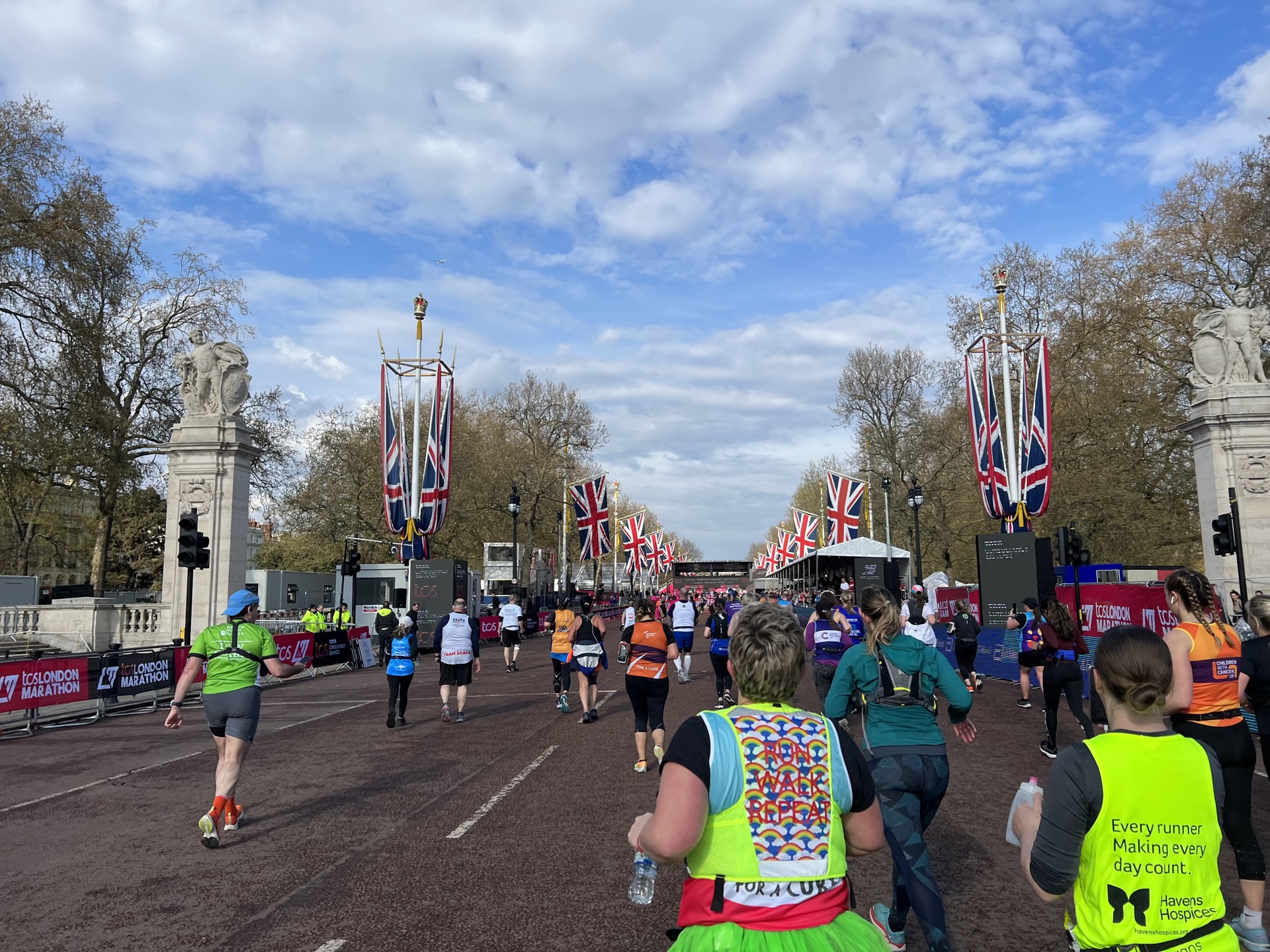
I was actually pretty worried about the race after reading about some terrible treatment of slower runners in 2019. However, after that, the London Marathon changed their practices to support runners for all speeds. Here’s a look at some of the current policies that cover runners toward the back.
- The race time limit is 8 hours from the very last start.
- Runners with an expected finish time longer than 7 hours can actually start in an earlier wave to give themselves even more time.
- Tailwalkers walk the course at an 8 hour pace from the very last start, after which the course will be cleared.
- Runners who fall behind the 8-hour pace will have to move to the sidewalk for safety reasons. However, if they want to continue, two Tailwalkers will join the athlete and support them to the finish.
- Water and aid stations will remain open until the 8-hour pace Tailwalkers pass. Any runners who continue at a slower past will need to be self-sufficient.
I can’t speak to the experience of runners in this pace group. However, in 2023 the final runner to cross the finish line did receive these services. He was walked by a Tailwalker the final three miles, and she ensured the finish line would remain open for him.
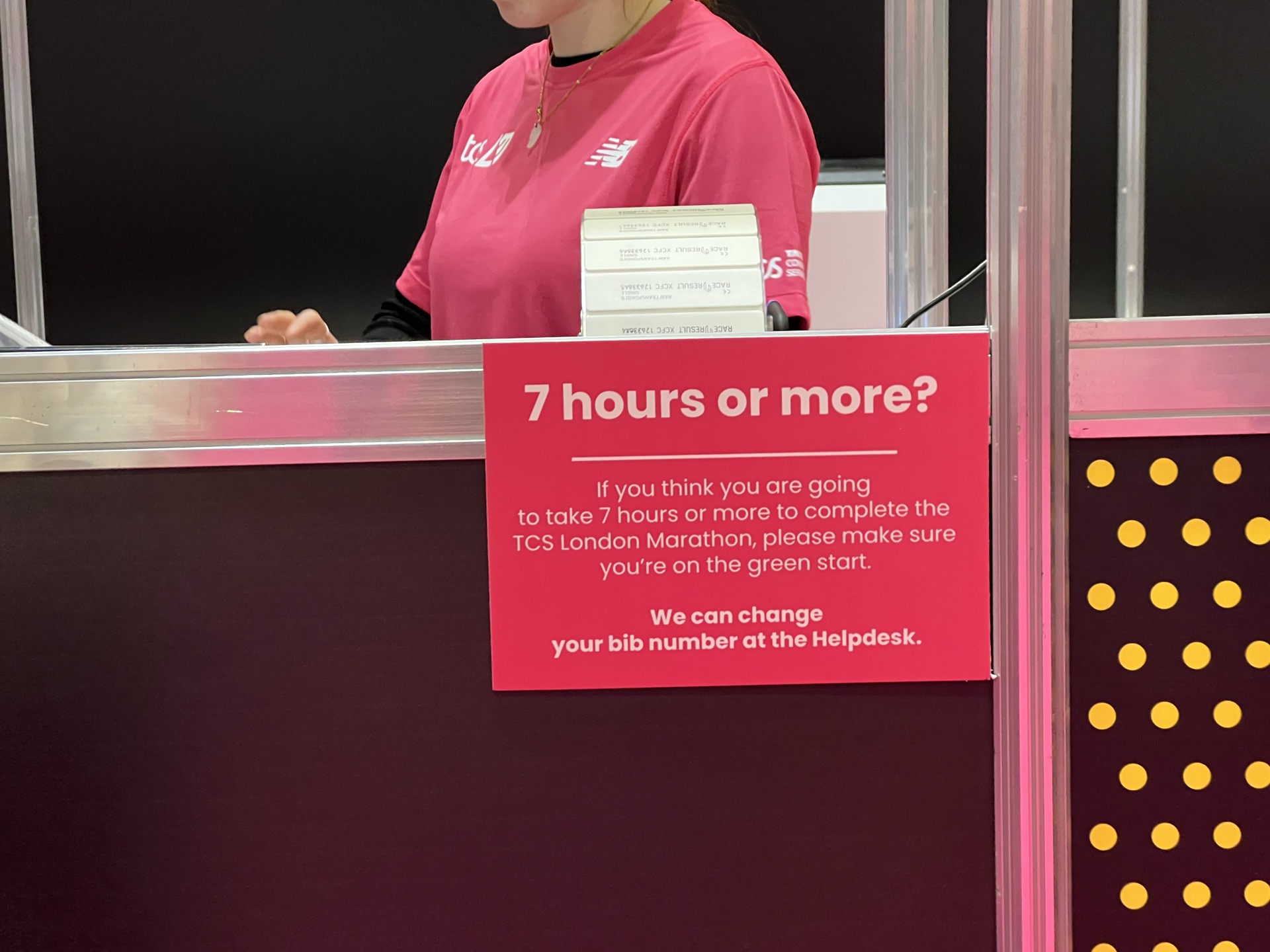
London Marathon Finish Line Area
After the finish line, I was immediately given my London Marathon finisher medal, at which point I broke down into tears. I had a bad race and was disappointed, but I was also really proud of myself for finishing a race I’d dreamed of for so long. Just past the medals, they distributed mylar blankets.
Historically, including during my race, they distribute finisher shirts at the finish line. However, in 2024, they made a pretty significant change to distribute the finisher shirts at the race expo.
People had very strong feelings about this. I personally prefer getting my shirt at the expo when it’s a participant shirt. But if that shirt is going to say “finisher” on it, I tend to agree that you should have to finish before you get it. I’m interested to see what they do in 2025.
If they do go back to giving out finisher shirts at the finish line, I’ll note my experience because T-shirt sizes are not guaranteed. I finished at 4:53 PM (almost 7 hours after the first start group) and received one of the last three smalls. You’re experience might vary, but hopefully that’s helpful context. Finisher shirts came in a bag with water, a sports drink, and an oatmeal bar.
There’s a straight path that leads on to the gear check retrieval, which had no lines or wait when I arrived. (I kind of regretted not checking a bag!) It’s a pretty long walk from the finish line to a place were you can sit in the park, but that’s pretty standard at these big races. (And definitely short compared to the NYC marathon, holy 27th mile!)
There’s no real finisher party at the end of the London Marathon. If you keep walking, you’ll eventually be able to enter the park if you want to sit. Otherwise, there’s family reunion areas and signs directing out to public transportation.
Leaving the London Marathon
The London Marathon ends on The Mall, it funnels runners toward the east side of St. James’s Park. Even as someone who’s otherwise comfortable in this part of London, I was pretty out of sorts after the race and had a hard time getting my bearings. My best advice is to follow the signs and unabashedly ask volunteers and strangers for help and directions.
The train is definitely your best bet to get out of the finisher area, because the roads are still closed for vehicles and buses. Signs around the finisher area point to the main nearby stations, which include Piccadilly, Charing Cross, Westminster, and St. James’s Park, and Victoria.
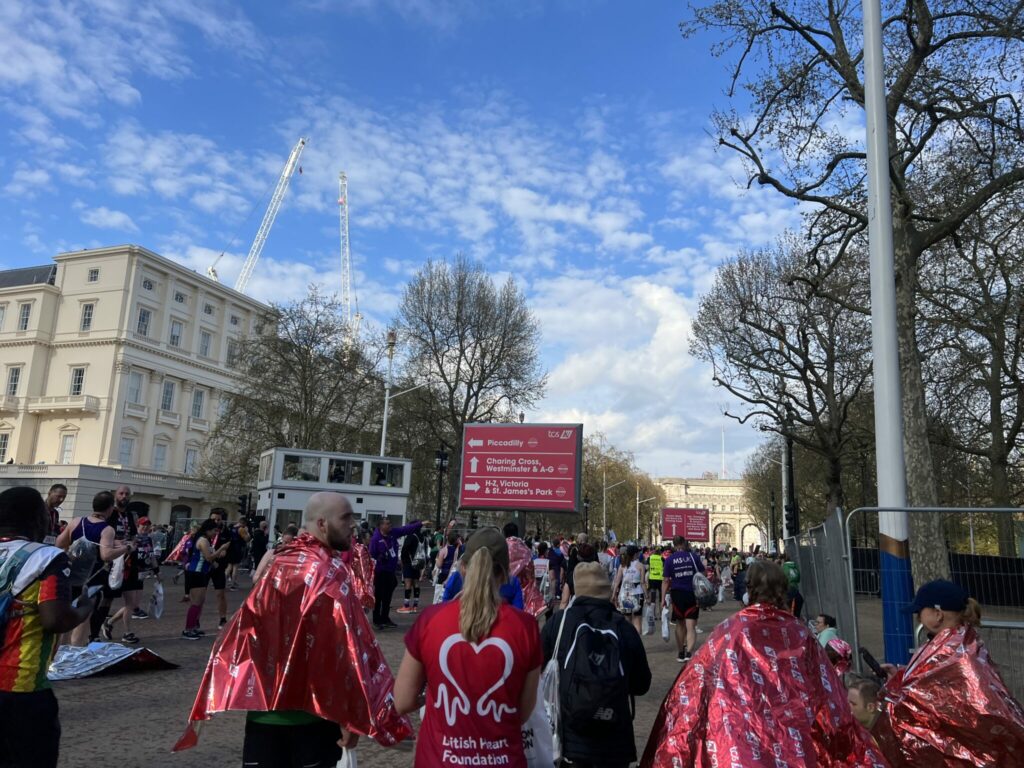
The train stations near the marathon finish area are really crowded after the race. To add to the chaos, runners still ride for free and were funneled through a specific gate. The agent at the station was constantly yelling instructions for which gates were for runners and which were for spectators. (This is probably why they changed to offering runners a transit card.)
Once you get through the gates and to the platform, everything settles down. The London Underground always has impressively frequent service, and race day was no different. Trains came and went as quickly as people filled the station.
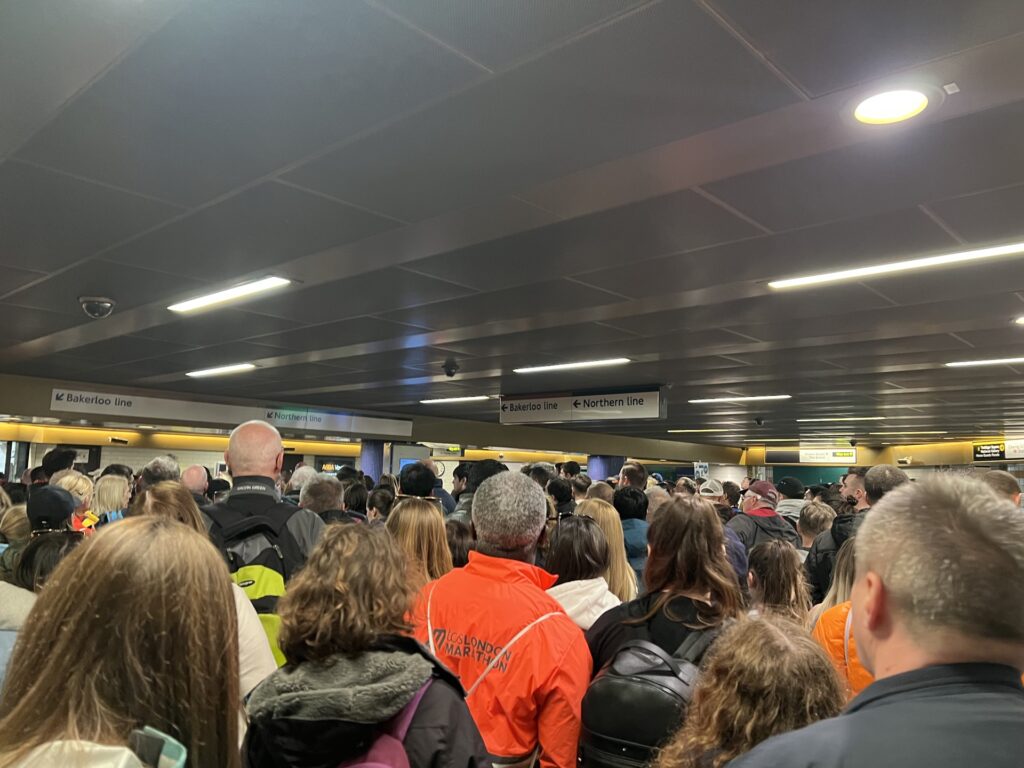
Sample London Marathon Weekend Itinerary
Scheduling your days around the London Marathon calls for a special kind of travel planning. It’s a delicate balance of fun vacation and serious running prep. It’s a run-cation. Everyone’s schedule and idea of fun looks different, but here’s how I spent my time in London for the London Marathon.
For reference, I was coming from New York City and I’ve been to London several times previously.
Thursday
- 9 PM: Flight departed from New York City. (Virgin Atlantic Upper Class on the A350)
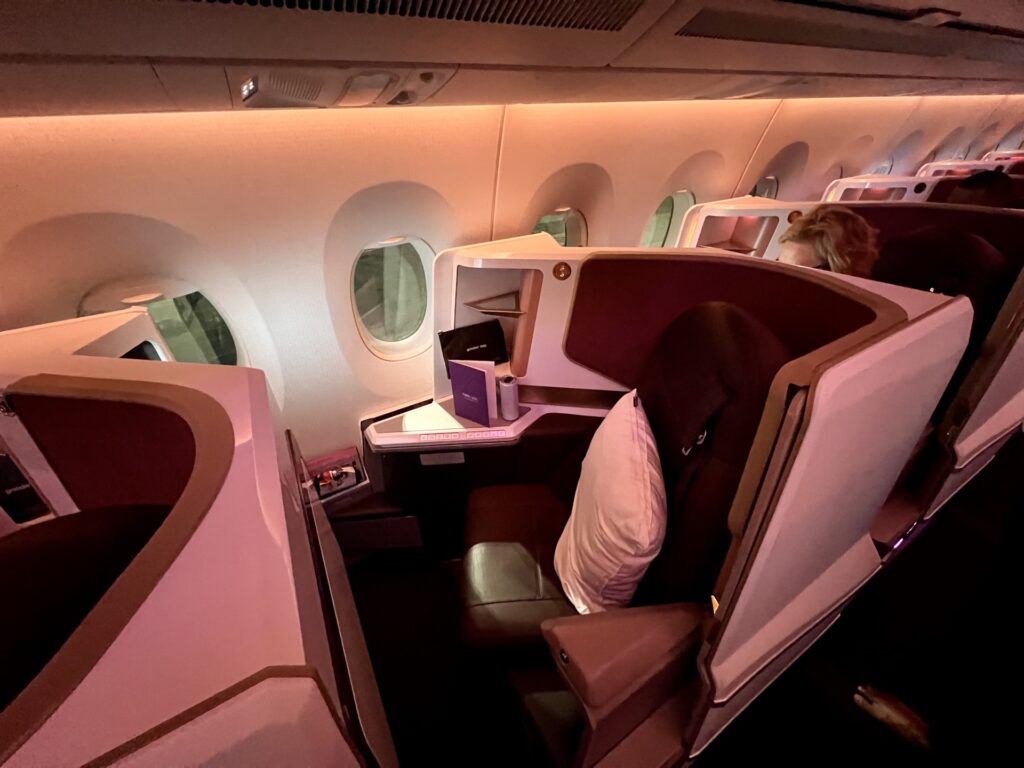
Friday
- 9:30 AM: Flight landed at London Heathrow. I briefly visited the arrivals lounge and then took the Elizabeth Line to my hotel.
- 12:30 PM: Dropped off my bags at Montcalm Royal London House (room not yet ready) and hopped back on the Elizabeth Line to the expo.
- 1 PM: Picked up my bib and did some shopping at the TCS London Marathon Running Show
- 3 PM: Took the Elizabeth Line again (3rd time today) to my hotel and finally ate lunch at a pub nearby. (Get the Halloumi at Kings Arms and thank me later.)
- 4 PM: Checked into my hotel room at Montcalm Royal London House
- 5 PM: I intended to go for a shakeout run, but I was too tired / it was too crowded / I just didn’t want to. Instead, I got coffee at Blank Street and took a long walk south to the Thames, over to the London Bridge, around St. Katherine Docks and back up through Spitalfields.
- 7 PM: I had club lounge access at the hotel, so I had a beer and ate some olives for dinner. #fuel (But for real, 10/10 do not recommend. Eat real, healthy food.)
- 8:30 PM: Good night!
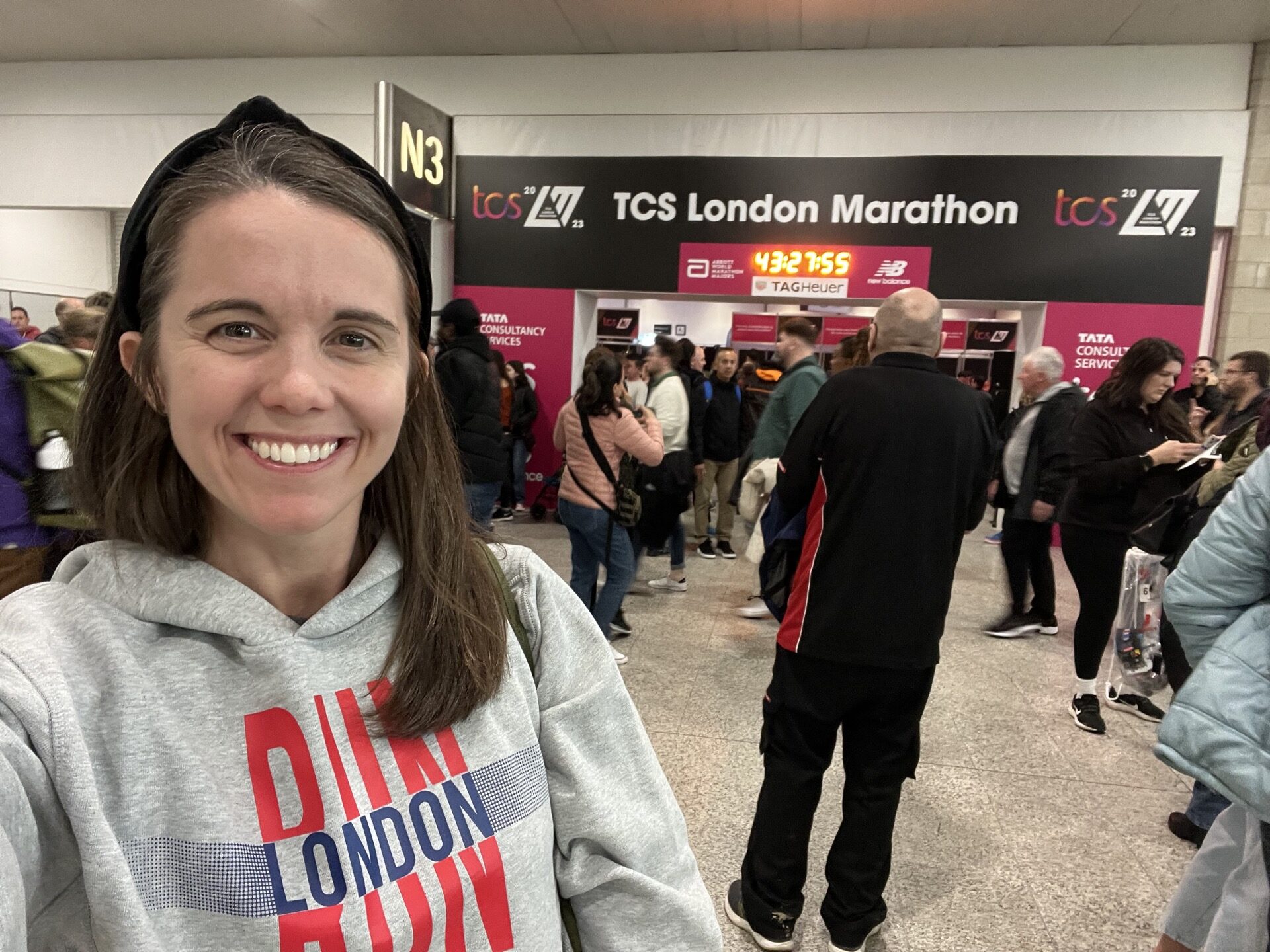
Saturday
- 10 AM: Ate breakfast at Sunday in Brooklyn, a restaurant I’ve been wanting to try for a while. (Make a reservation in advance!)
- 11 AM: Explored the Notting Hill neighborhood, including Portobello Market, sugar cookies from Biscuiteers, and of course The Notting Hill Bookshop.
- 4 PM: Late lunch / early dinner of pasta from Chi Chi + The Pasta Family.
- 5 PM: Pit stop at the nearby Tesco Express to pick up some evening snacks, plus coffee and breakfast for race morning.
- 6 PM: I spent the rest of the evening at my hotel watching a movie. Every part of me wanted to go out, but I couldn’t think of anything to do other than walk around (didn’t want to waste the energy) or go to a pub (drinking didn’t seem like a good idea).
- 9 PM: Good night! Well, that’s when I tried to go to sleep. I realistically fell asleep much later.
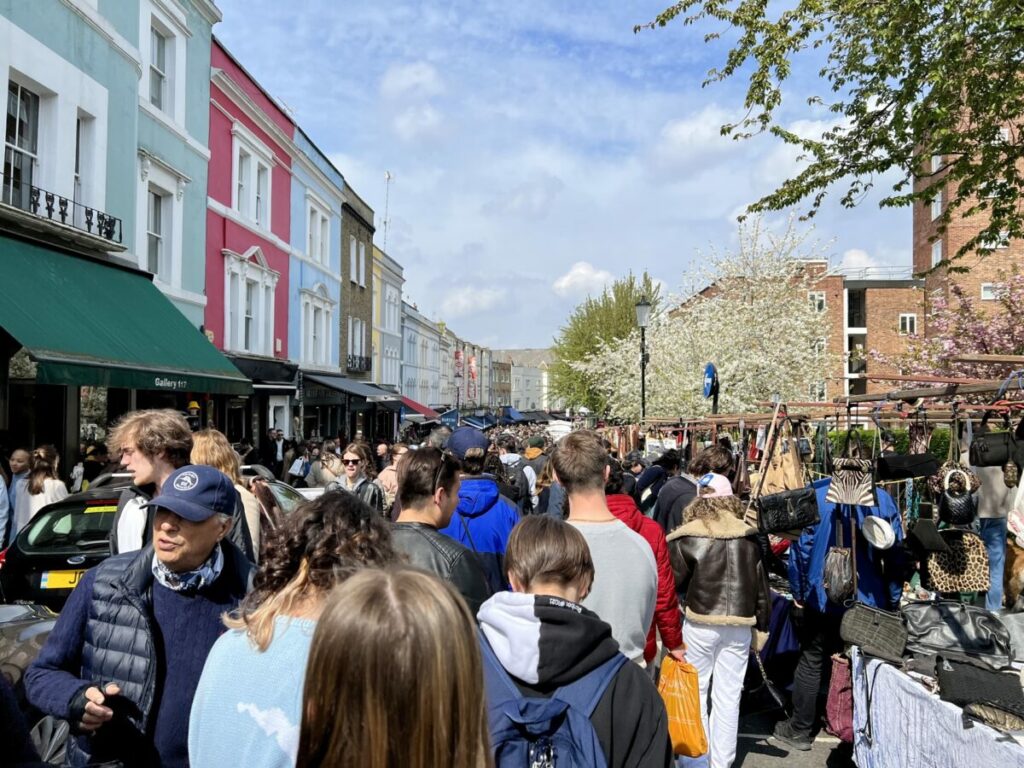
Sunday
NOTE: I was Red Start, wave 11. My recommended arrival time was 10:08 AM and my scheduled start time was 11:05 AM. Review your pre-race communication for your exact location and timeline.
- 8:30 AM: Breakfast and coffee in my room. (Instant oatmeal and a canned double shot)
- 9:15 AM: Left the hotel for the starting line. I took the London Underground Northern line from Moorgate to London Bridge, then switched to a Southeastern train from London Bridge to Blackheath. (Blackheath isn’t the recommended station for the Red Start, but I got on the wrong train.)
- 10:15 AM: Got off the train in Blackheath after a 30 minute delay.
- 10:35 AM: Arrived at the Red Start area.
- 11:05 AM: Started the London Marathon, right on schedule.
- 4:45 PM: Finished the London Marathon.
- 5:30 PM: Left the marathon finisher area and St. James’s Park.
- 6:15 PM: Arrived back at my hotel. Before I got there, I popped into Tesco for one of my favorite sandwiches (Cheddar Ploughman’s) and some snacks to eat for dinner at the hotel. I was just too tired to go to an actual restaurant.
- 7 PM: A celebratory beer and more olives in the club lounge. (I am who I am.)
- 9 PM: Good night!
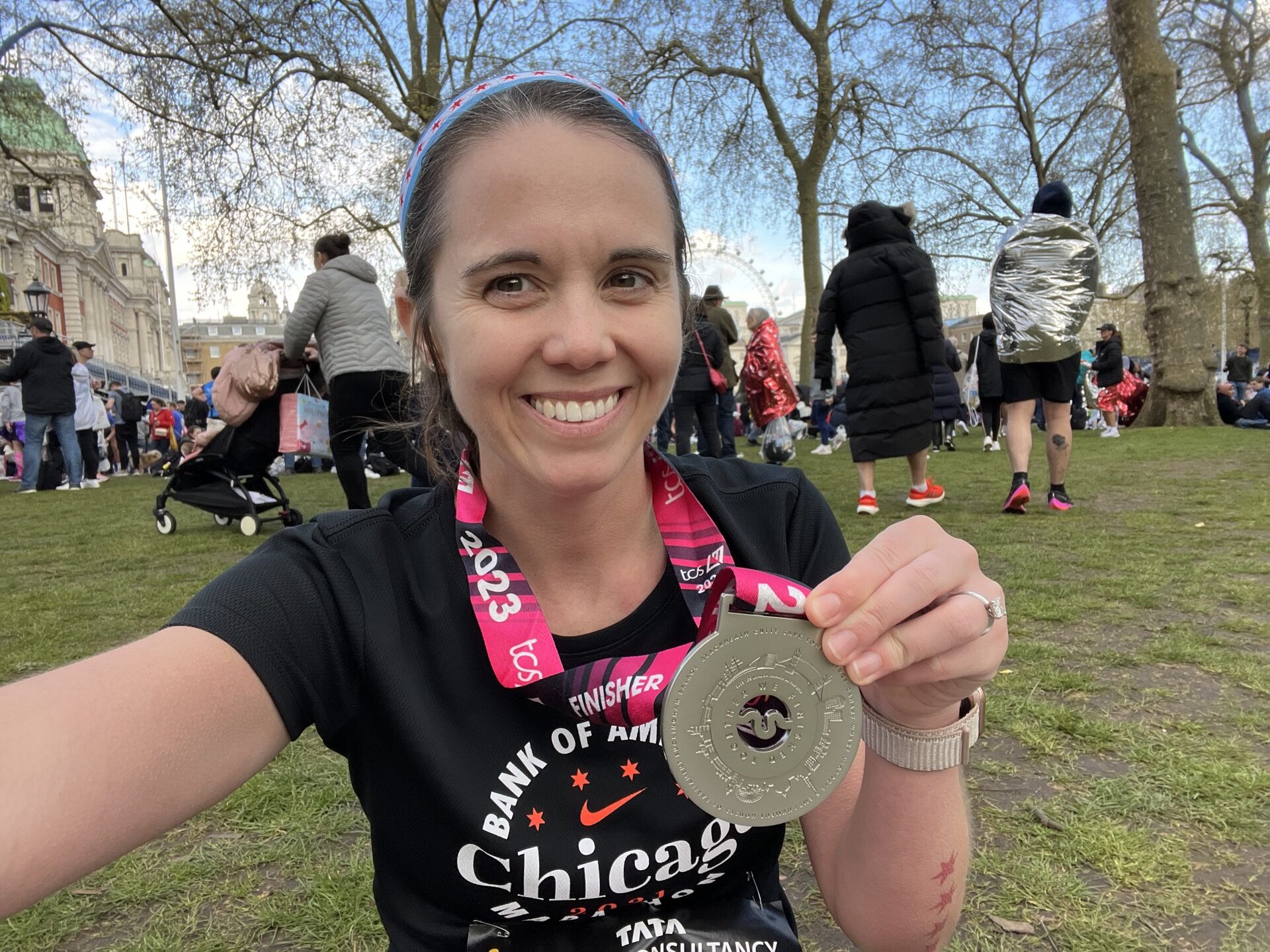
Monday
- 10 AM: Breakfast at the hotel
- 11 AM: Checked my bags with bell services.
- 11:30 AM: Coffee at Urban Baristas
- 12 PM: Finisher medal photo shoot at and around the London Bridge. I personally love the view from the south bank best. I also highly recommend asking someone to snap a pick for you if you’re alone! I was too embarrassed to ask, but some kind soul offered and I really appreciated it.
- 12:45 PM: Hopped on the river bus (aka Uber Boat by Thames Clippers) for a lovely ride from Tower Bridge to Embankment. I also got a beer onboard just because it was an option.
- 1:45 PM: Strolled through the always beautiful St. James’s Park and had a picnic with all of my leftover Tesco goodies.
- 2:30 PM: Took an wander around Mayfair and Soho. I left through Green Park, walked over to Piccadilly Circus, up Regent Street toward Carnaby, popped into Hamleys to see if they had a toy for my kiddo, then jumped on the Central line back to my hotel.
- 4 PM: Went back to my favorite pub by the hotel for dinner. (Again, I went to Kings Arms. Again, I got the halloumi. And again, it was amazing.)
- 4:45 PM: Panicked when I realized that my 20:15 PM flight was at 8:15 PM not 10:15 PM. I rushed to the hotel in the rain to pick up my bags, then took the Elizabeth Line to Paddington where I switched to the Heathrow Express to the airport.
- 6 PM: Arrived at Heathrow. Turns out I didn’t need to panic. I had plenty of time.
- 8:15 PM: Flight departed. (Virgin Atlantic Upper Class on the A330-300)
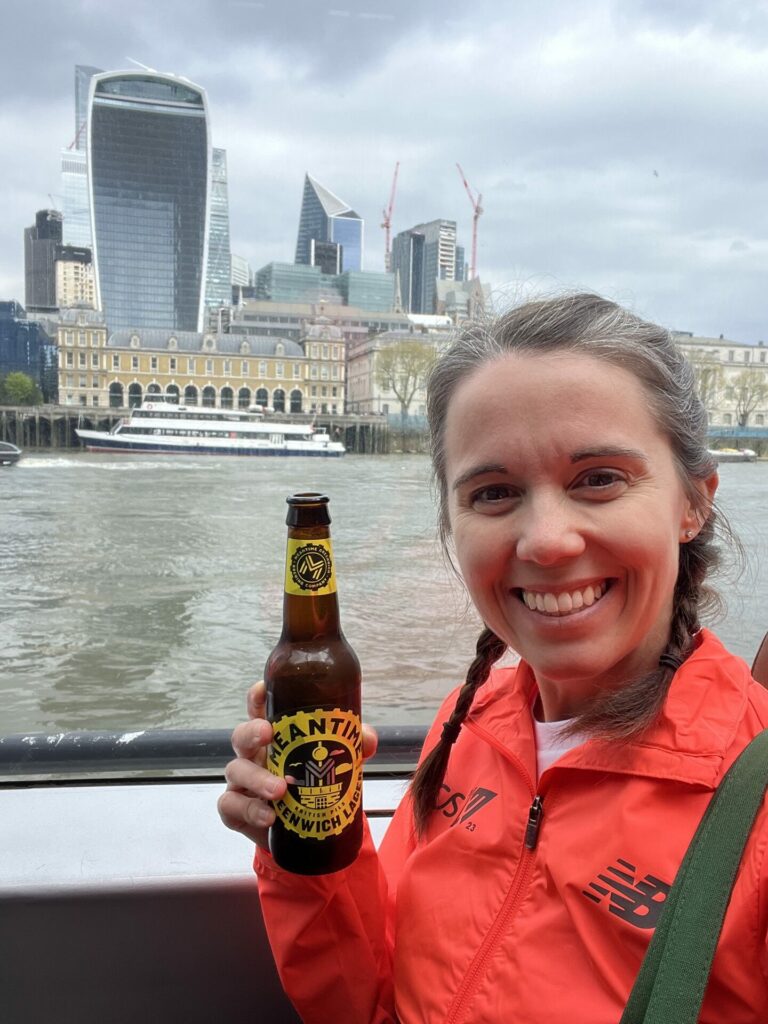
London Marathon Packing List
This is not a detailed packing list, but I wanted to share some of the most important things I remembered to pack and a few things I wished I had.
For the Race
- Race Clothes: The running gear you’ve trained in, that is tried at true! Don’t forget every single part like socks, underwear, sports bra, headbands or sweatbands, compression accessories, etc.
- Fuel: Fuel on the course is not great. I’d recommend bringing whatever you train with at home.
- Running belt: You’ll need this to carry your fuel and other essentials. Be sure to train with whatever belt you choose. (I’m partial to the FlipBelt.)
- Mylar blanket: You will get one at the end, but bring your own for the morning.This is great if it’s cold, but it’s also great if it’s raining. I had one I saved from a previous race, but you can also buy them on Amazon.
- Donation clothes: It’s often chilly in the morning, so bring a pair of pants and sweatshirt that you can part ways with. Before the start, you can ditch them with volunteers to be donated.
- Portable charger: I ran with a small, portable charger. It seems aggressive, but my phone always dies during marathons. I knew I’d want my phone after the race to look up directions and take photos. I brought a FuelRod that I bought in Disney World, but there’s a ton of options out there.
- Toenail Clippers: These are easy great to have for pre-race emergencies. (But don’t worry, they do sell them in London if you forget.)
- Handkerchief: This isn’t essential for everyone, but it is for me because my nose runs a lot when I run.
- AirPods or headphones: If you listen to music or audio.
Other Essentials
- Credit Card(s): Everywhere in London takes card, so you might not even need cash. Be sure to bring multiple cards, just in case there’s an issue with one. Also, if you booked a hotel on a certain card (particularly for points), be sure to bring that specific card.
- Debit Card: In the rare case you do need cash, you’ll want to have a debit card. (We like the Schwab Bank Investor Checking account because it has no ATM fees.)
- Outlet converter: They use Type G plugs in the UK. If you’re traveling internationally, you may need a converter.
- Comfortable walking shoes: You’ll probably be doing a lot of walking on either side of the race, so make sure you have something comfortable. I’d suggest bringing a separate pair, in addition to your running shoes.
10 London Marathon Tips for Travelers
- Start your packing list early. When you go for your long run, make a list of exactly what you wear and what you bring. Double check it and update it before every long run. That way, you have a complete list of everything you know you need to pack for the London Marathon.
- Plan your pre-race meal. Figure out what food(s) you like to eat the night(s) before your race. Then research restaurants in London so you know you can get that exact meal (or as close as possible) before the actual race. Personally, I just have pasta and red sauce, which is easy to track down.
- Train in waterproof shoes. Once I started wearing waterproof shoes, I couldn’t stop. You never know when it’s going to rain, and it’s so nice to have dry feet if it does. My husband and I both own multiple pairs of Nike Gortex waterproof running shoes, which are a great option.
- Pick a hotel with blackout curtains. This is a true game changer for getting sleep and adjusting to jet lag! Both of my personal hotel recommends (Montcalm Royal London House and Bankside Hotel) have them. If you’re worried about sleep, I’d also recommend trying the Liquid I.V. Sleep Multiplier.
- Put your name on your shirt. The spectators in London really got into cheering for people by name. This is a great way to get spectator support, especially if you don’t have personal fans on the course. If you can’t get a custom made shirt, writing it in Duck Tape (or something similar) is an easy, temporary option. They also sometimes do shirt printing at the expo, so be sure to check on that if you’re interested.
- Memorize your transportation to the start. There is almost never service on the London Underground. Know your route before you leave so you don’t have to rely on looking up maps on the way.
- Leave before your suggested train. The pre-race communication will tell you exactly what train arrival times you should be on for your start wave. Leave before that. They do their best, but the trains are packed, which often results in delays.
- Go to the bathroom in the start area. The London Marathon was a rare case where the bathrooms in the start area didn’t have massive lines! Instead, the bathrooms on the course had lines. Try to go before if you can.
- Bring your own fuel. I know I sound like a broken recon on this, but I didn’t bring my own and deeply regretted it. Whatever fuel you use for training, bring it with you to London and carry it on the course. I never do this for races, but I needed to do it for London.
- Take photos on the course. Take the selfie crossing Tower Bridge! It may seem awkward or you don’t want to slow down, but unless you’re trying to Boston-qualify I promise you it’s worth it. The course is epic and is worth documenting with at least a couple photos. Plus, the race photographers were not that good and I was hardly in any photos. I would have been disappointed if I was relying on those pictures.
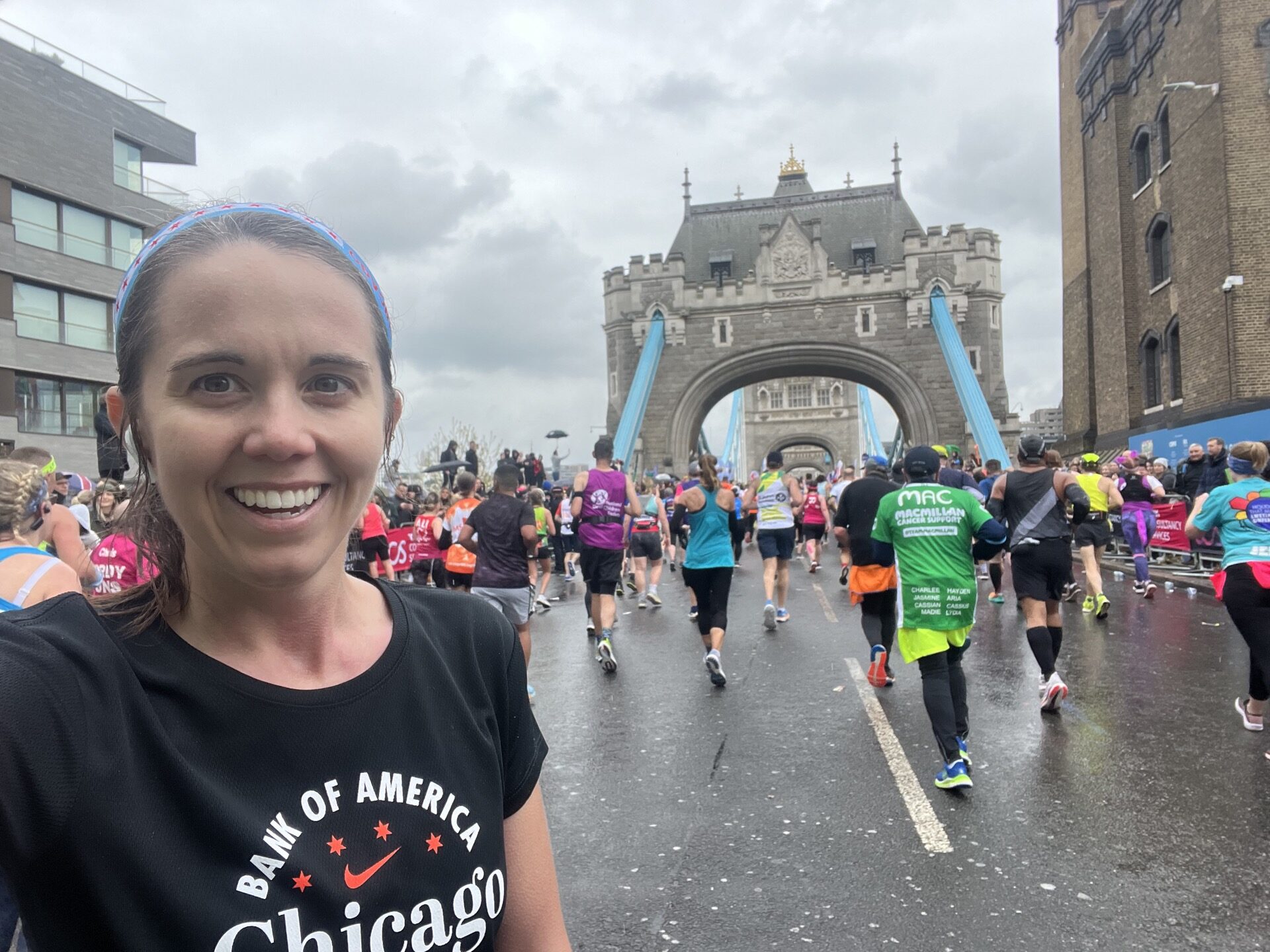
And one more bonus tip …
Relax and ENJOY IT! I had a bad race. I built the race up so much in my head, I trained so hard and thought I might PR, and then it didn’t work out for me. I got sick, I didn’t sleep at all, and my nutrition was garbage. (I’ll spare you the photo of the selfie of me ugly crying after the finish line.)
It’s so true what they say — control what you can control. I couldn’t control how I physically felt that day, but I did have control over my attitude. In the moment, I let the negativity take over and I still regret that.
If I could go back in time, I’d let all of that go and try to soak up every moment of those 26.2 miles.
Good luck and enjoy the race! And if this post helped you at all, please let me know in the comments! I’d love to hear how your race was and anything you learned along the way.

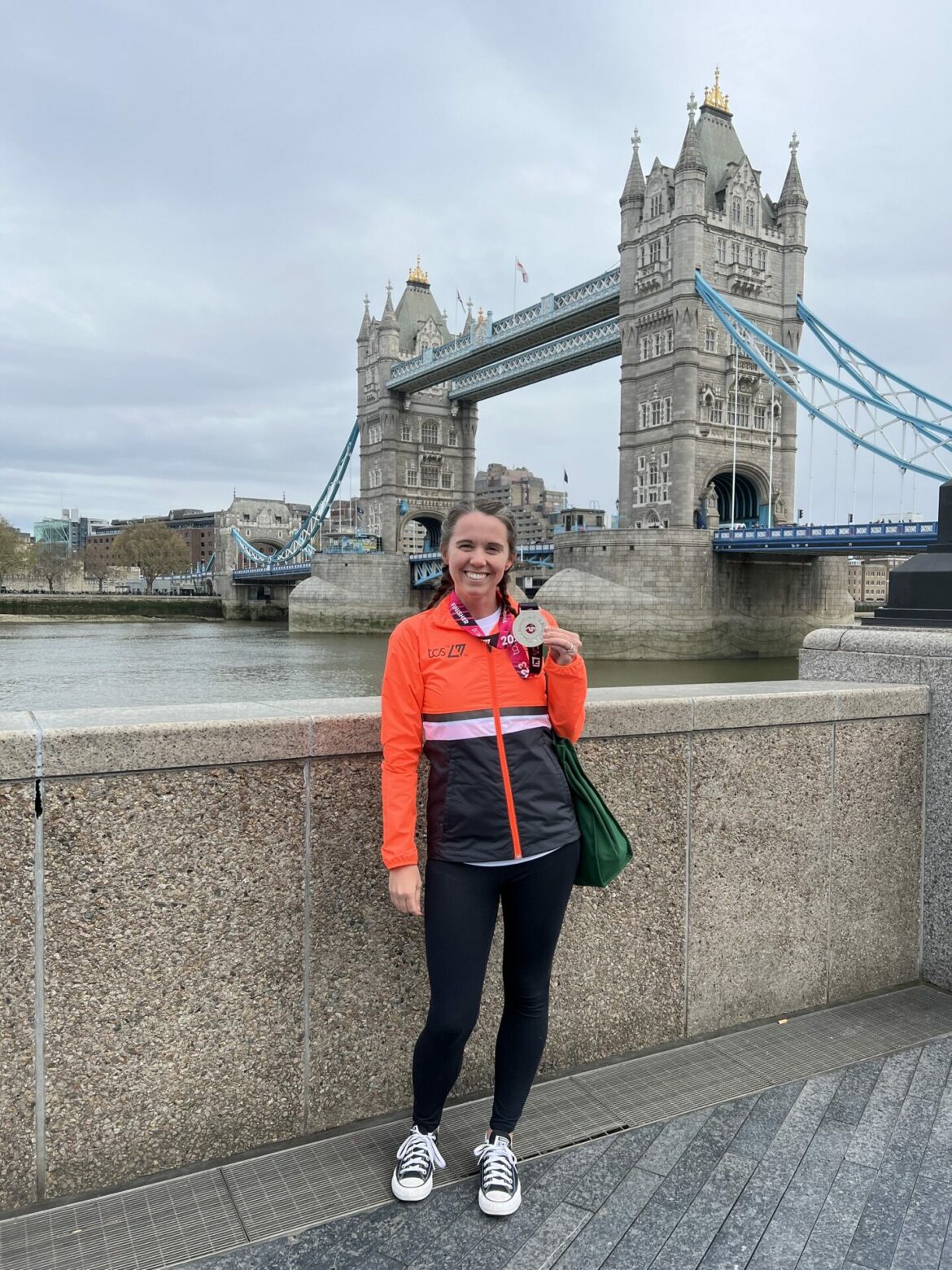
One response to “A Tourist’s Guide to the London Marathon”
Excellent article! You covered all the important aspects really well. Looking forward to your next post.